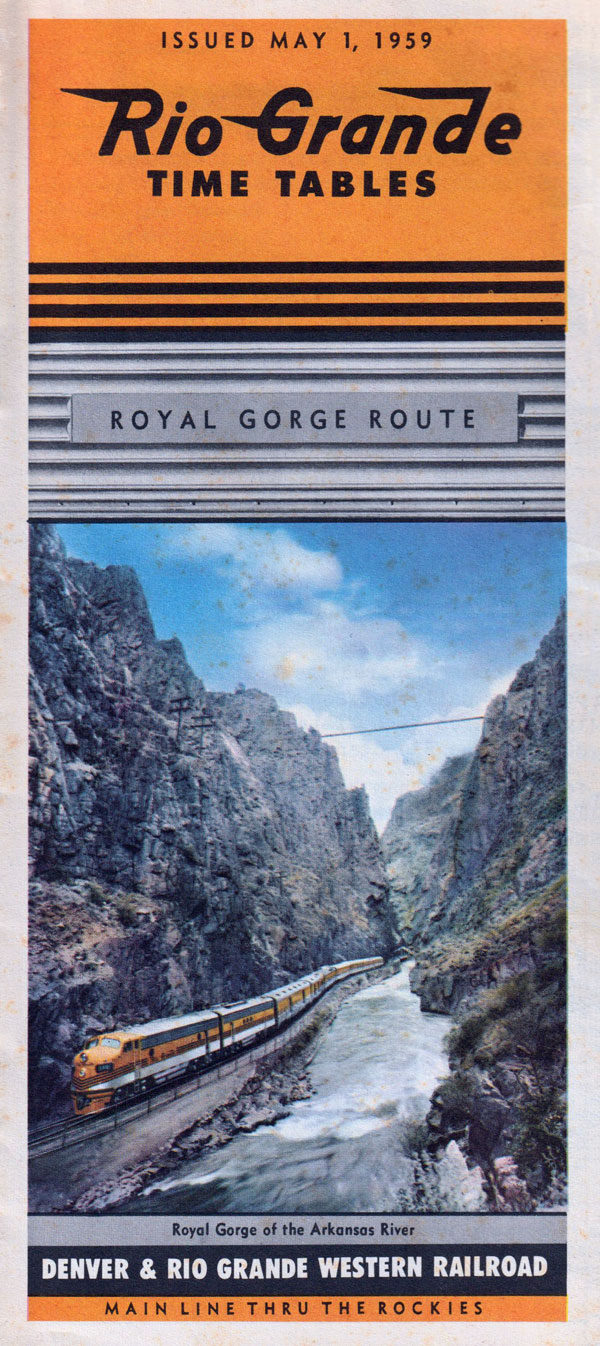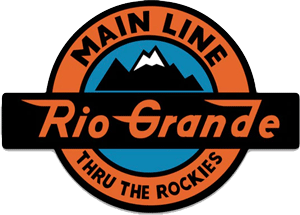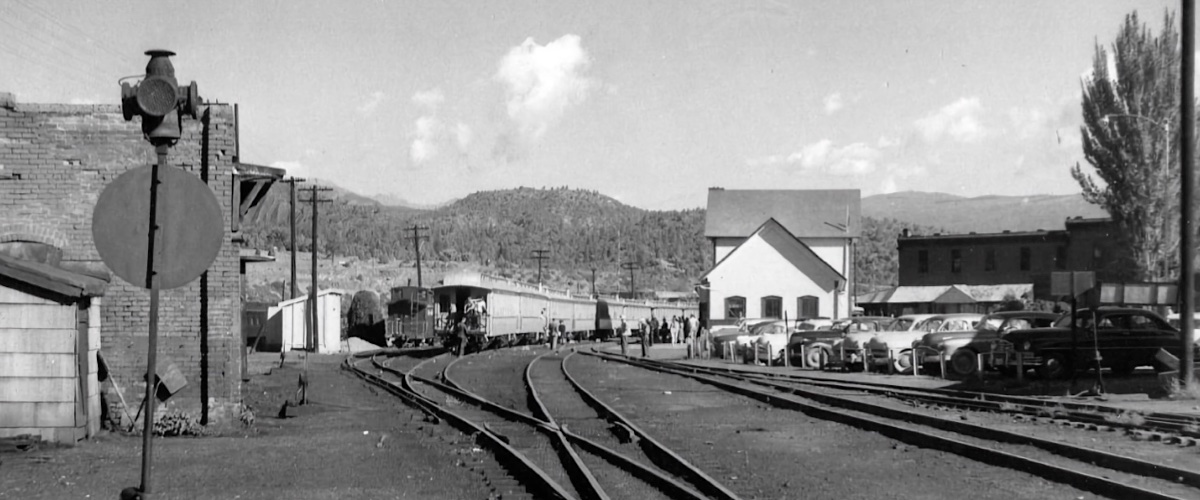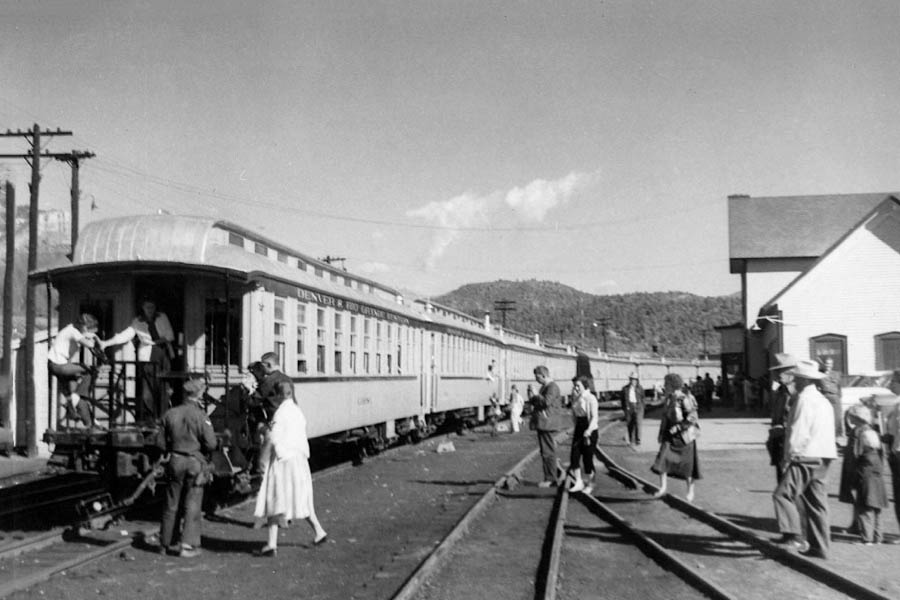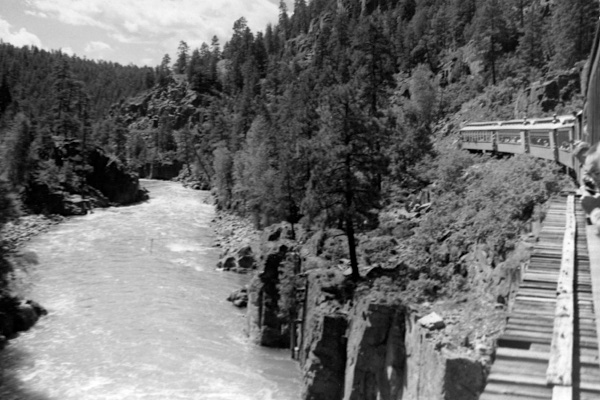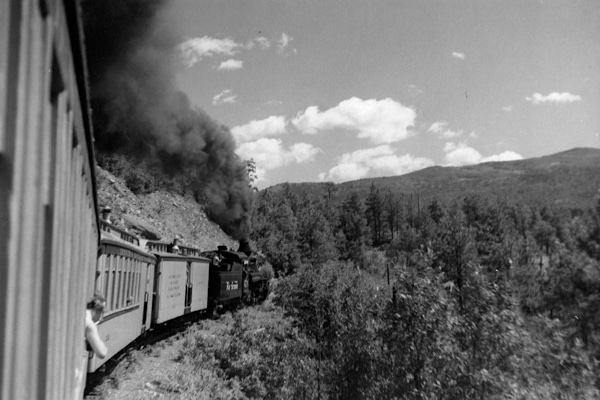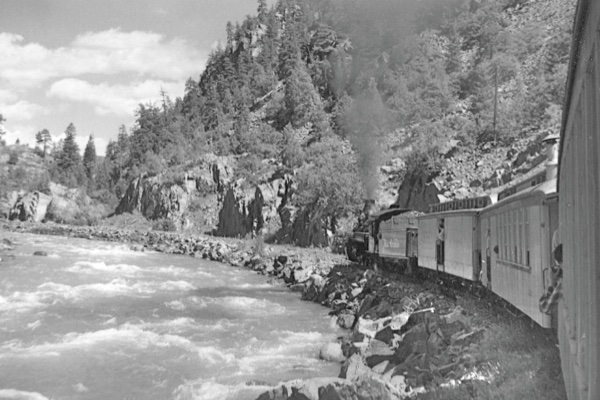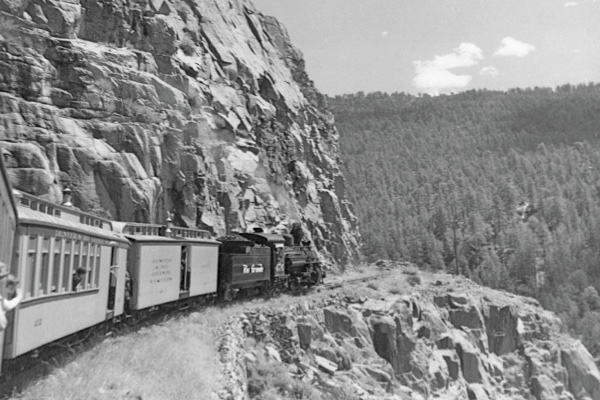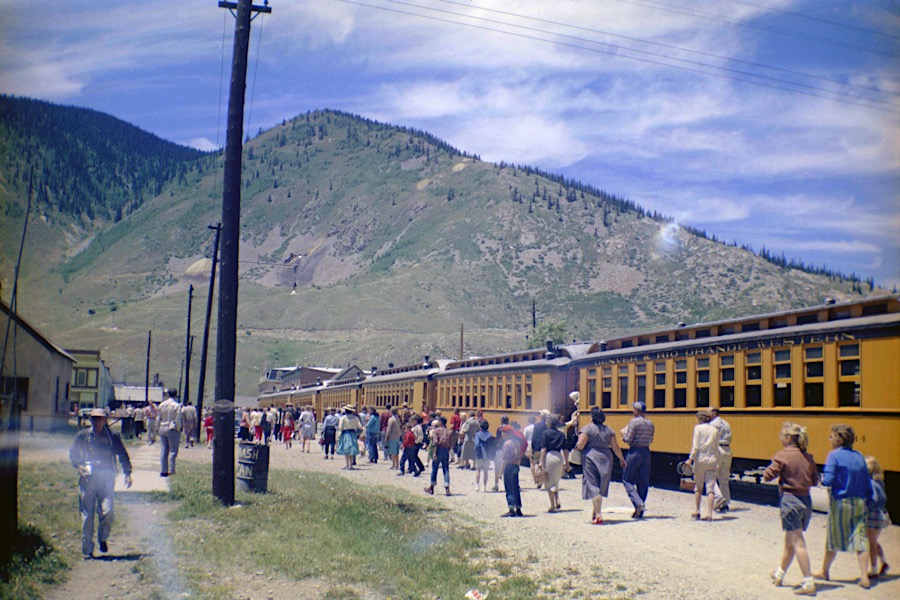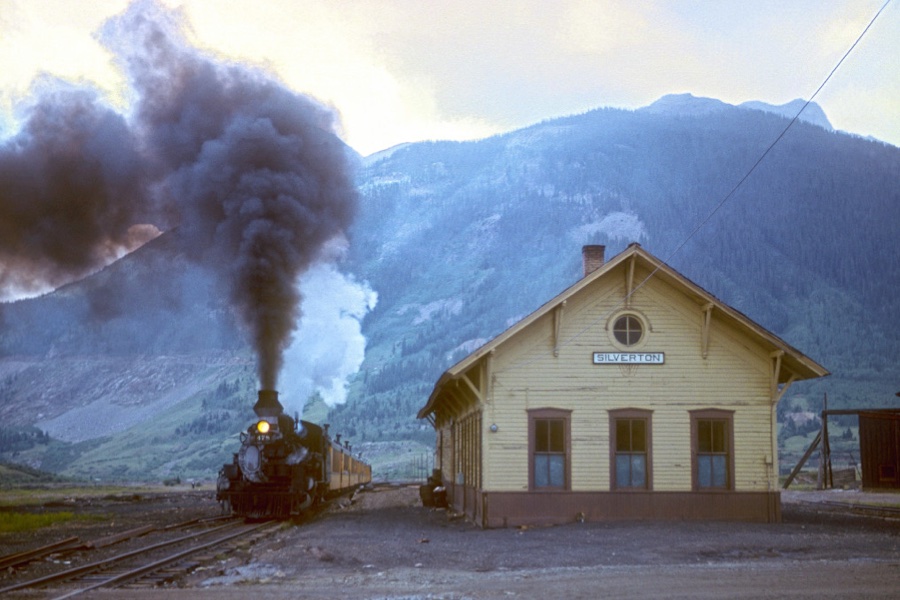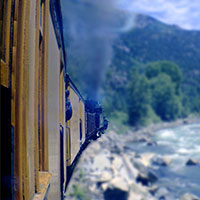 |
Denver & Rio Grande Western Silverton Mixed Train |
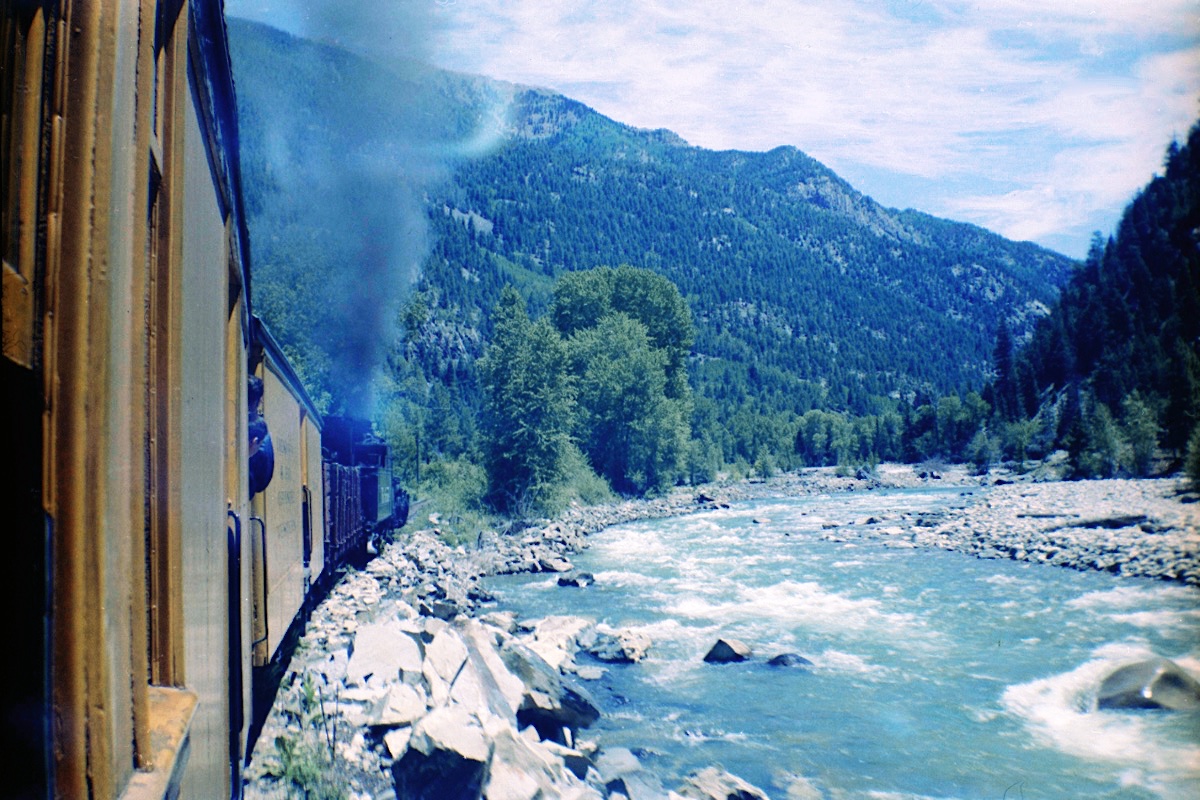
Cascade, Co / Jun 1958 / JCH

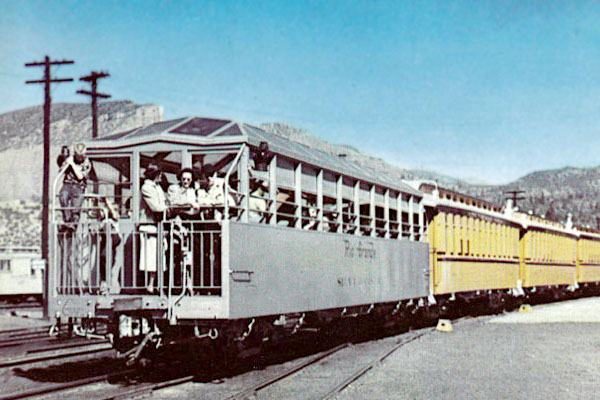
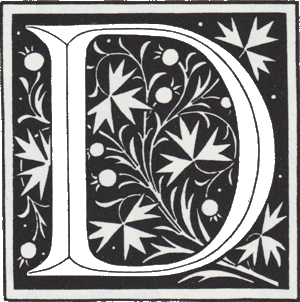 own in Southern Colorado and New Mexico, the Rio Grande operates 571 miles of narrow gauge railroad. Of the equipment listed in the accompanying statistics, 36 steam locomotives, 31 passenger cars, 2,554 freight cars and 142 units of company equipment are included which serve the three-foot lines. The last regular narrow gauge passenger train, on the 200-mile Alamosa-Durango run, was discontinued early in 1951, and the only remaining passenger service is a mixed train from Durango to Silverton, 45 miles, running once a week in the winter, and three days a week in the summer. A glass-topped "silver vista car" is attached to the train during the tourist season.
own in Southern Colorado and New Mexico, the Rio Grande operates 571 miles of narrow gauge railroad. Of the equipment listed in the accompanying statistics, 36 steam locomotives, 31 passenger cars, 2,554 freight cars and 142 units of company equipment are included which serve the three-foot lines. The last regular narrow gauge passenger train, on the 200-mile Alamosa-Durango run, was discontinued early in 1951, and the only remaining passenger service is a mixed train from Durango to Silverton, 45 miles, running once a week in the winter, and three days a week in the summer. A glass-topped "silver vista car" is attached to the train during the tourist season.
Handbook of American Railroads
/ 1951

collection

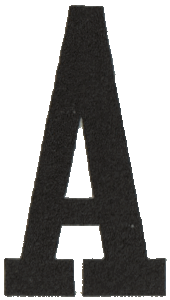 fter World War II, the once enormous narrow gauge footprint of the Denver & Rio Grande Western Railroad in Colorado began to shrink as passenger and freight revenues declined along the 36" gauge San Juan extension, from Alamosa west to Durango. The associated Silverton Branch — between Durango and Silverton — also suffered, as mining interests dried up, freight traffic moved to highways, and snow slides and floods challenged the remote right of way.
fter World War II, the once enormous narrow gauge footprint of the Denver & Rio Grande Western Railroad in Colorado began to shrink as passenger and freight revenues declined along the 36" gauge San Juan extension, from Alamosa west to Durango. The associated Silverton Branch — between Durango and Silverton — also suffered, as mining interests dried up, freight traffic moved to highways, and snow slides and floods challenged the remote right of way.
The Silverton Branch would surely have been abandoned, where it not for its scenic beauty and the rise of domestic tourism in the region in the years following the War. The line received national exposure following the filming of several movies on location, and in response to public interest in 1947 the railroad launched The Silverton — a summer-only daily passenger service between Durango and its namesake destination. The modest effort to attract tourist riders proved successful, and to cope with the continued loss of freight revenue the daily passenger run was for many years operated as a mixed train.
By the 1960s, the modern Denver & Rio Grande Western no longer wanted to operate the remote Silverton line or its slim gauge tourist trains, and thus petitioned the Interstate Commerce Commission for abandonment. The petition was denied, because the route was determined to be so important for regional tourist patronage. As a result of the ruling, the mainline railroad reluctantly made investments in the branchline, its locomotives and rolling stock, and the Durango depot. D&RGW operated the Silverton as a dedicated steam-powered narrow gauge tourist-hauler throughout the 1970s. However, the line was sold in 1979 to Charles Bradshaw, a monied Florida citrus grower, thus ending the Denver-based railroad's century-long 36-inch presence in the San Juan mountains. Bradshaw kept the line active as a popular tourist hauler, and today the Silverton branchline is owned by American Heritage Railways and operated as the Durango & Silverton Narrow Gauge Railroad.

See also our complete Durango & Silverton Narrow Gauge Railroad scrapbook in Preservation
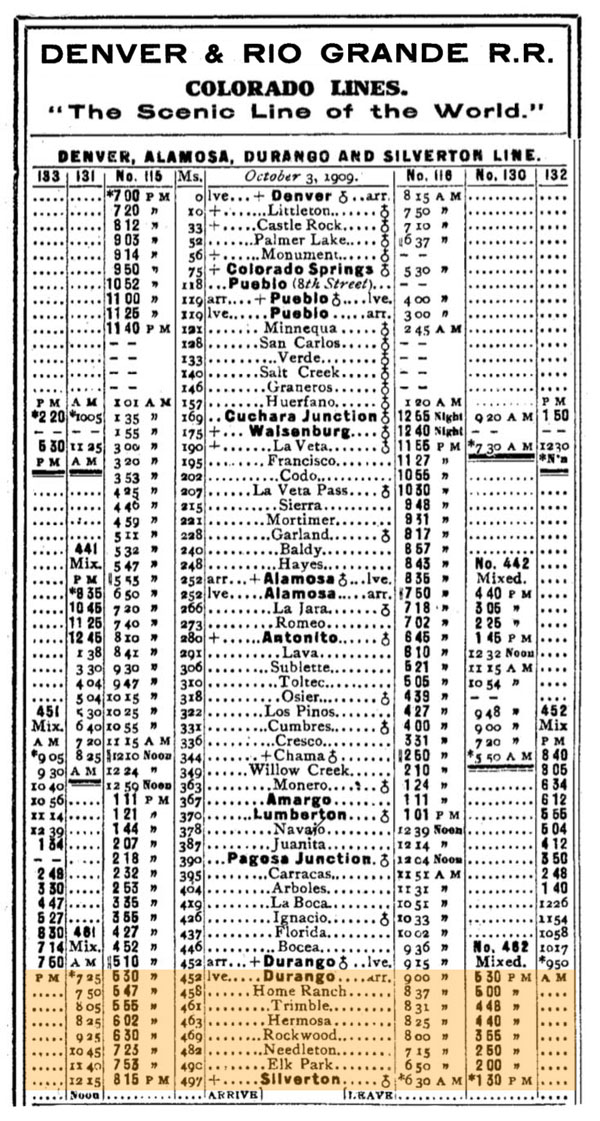
1910 Official Guide table / collection
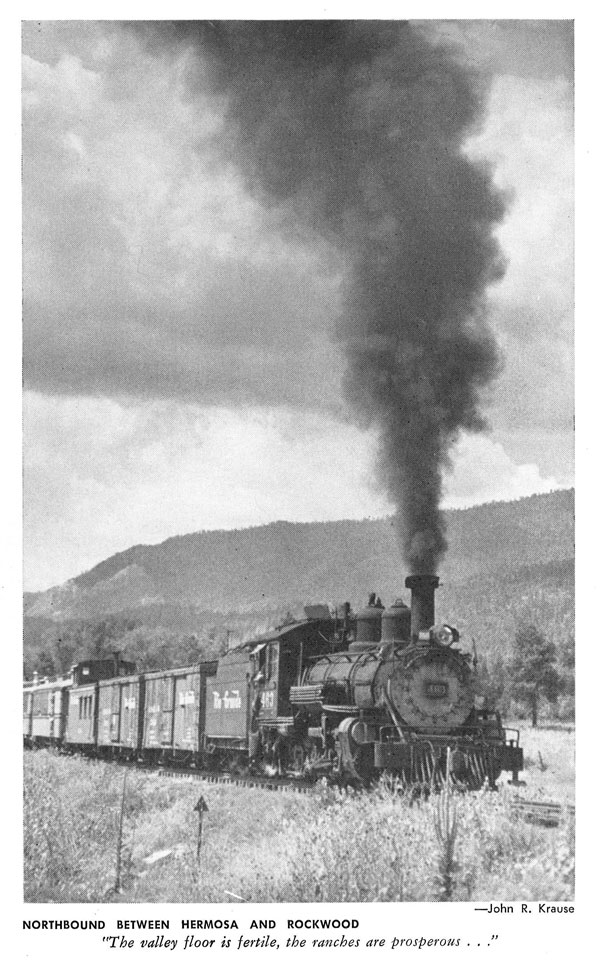
from Narrow Gauge to Silverton / collection
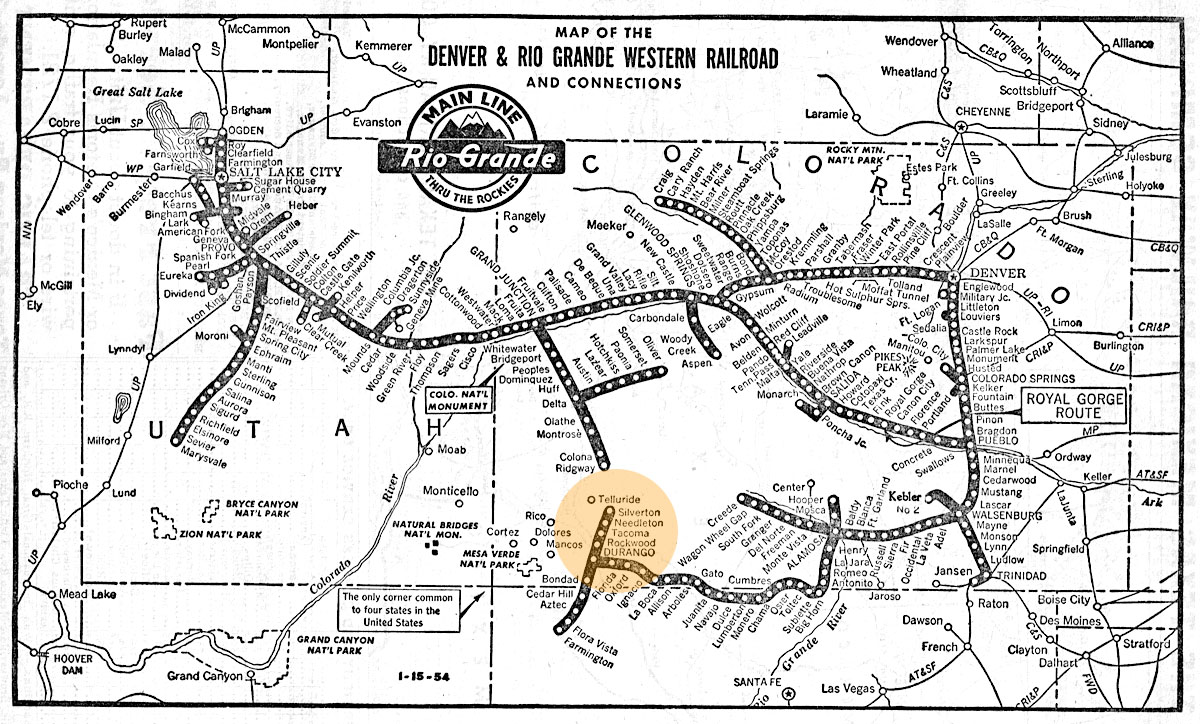
1954 DRGW route map / collection
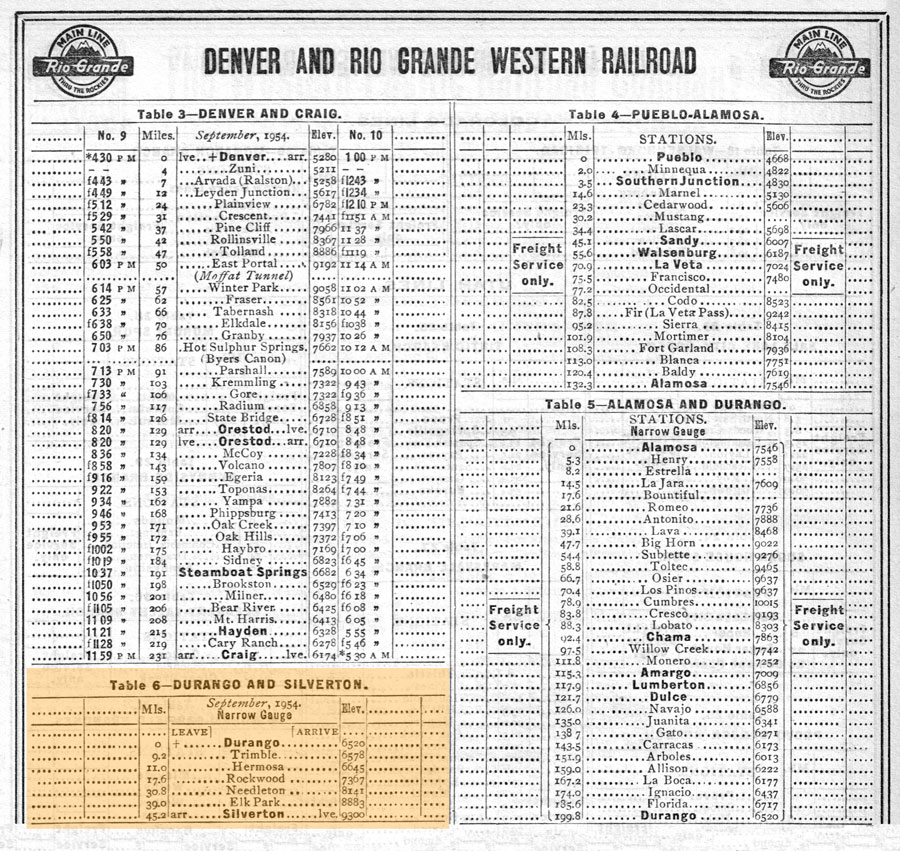
1954 Official Guide tables / collection
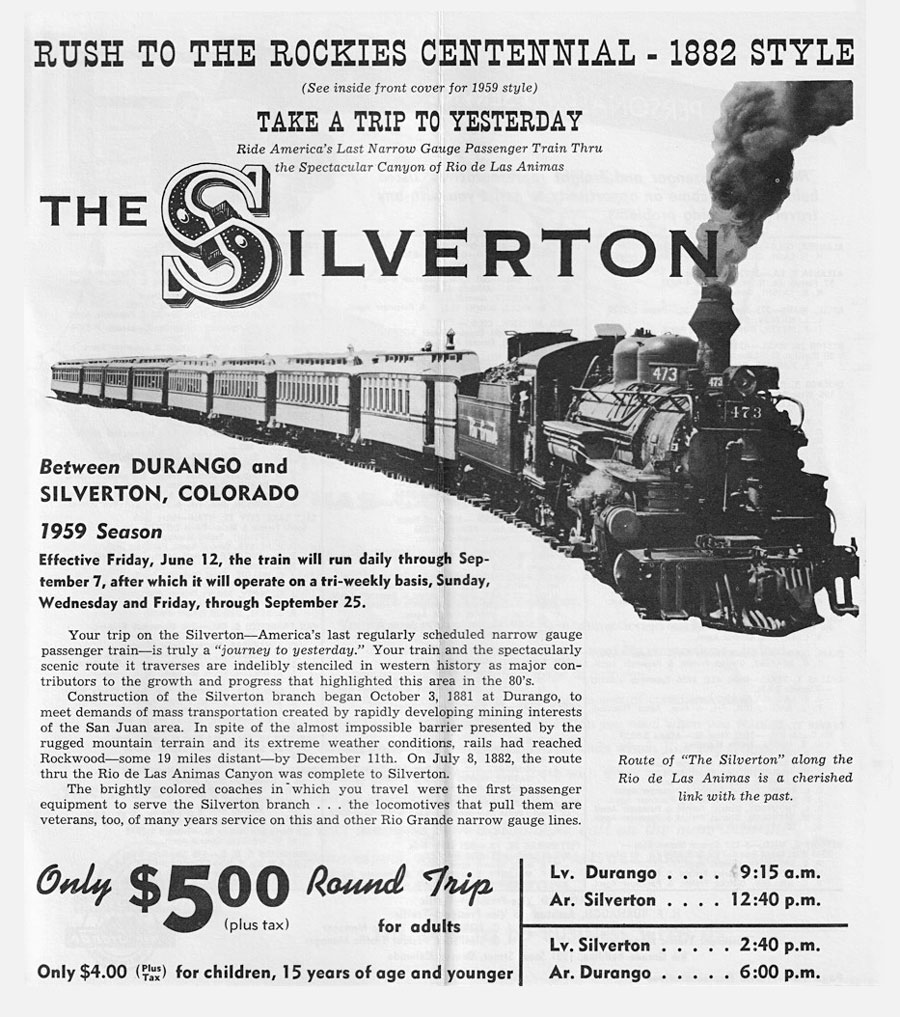
1959 timetable / collection

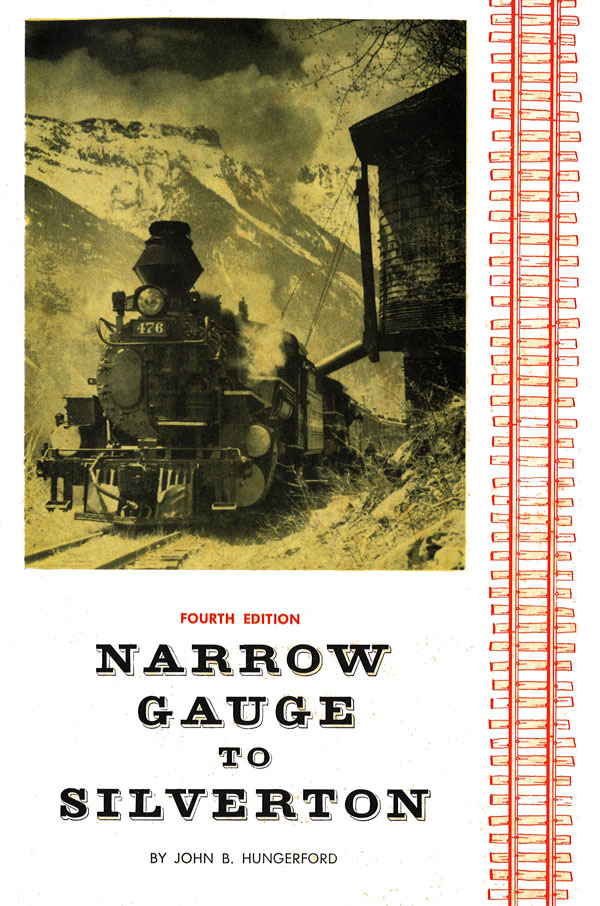
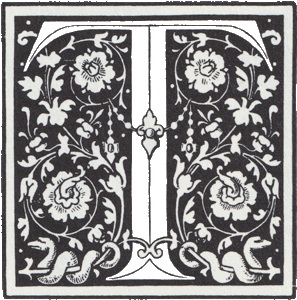 HE MOUNTAIN WONDERLAND of the San Juan Country of southwestern Colorado, in addition to its mighty peaks with perpetual snow and the scenic grandeur of the entire area, possesses an American heirloom, the Silverton Branch of the Denver and Rio Grande Western Railroad.
HE MOUNTAIN WONDERLAND of the San Juan Country of southwestern Colorado, in addition to its mighty peaks with perpetual snow and the scenic grandeur of the entire area, possesses an American heirloom, the Silverton Branch of the Denver and Rio Grande Western Railroad.
Here, nestled in a crevice on the roof of the continent, is a railroad uniquethe last narrow gauge passenger common carrier in the United States. Time was when narrow gauge tracks extended 16,000 miles throughout the country and interlaced 42 different states, but that was back in the 19th century. Times and conditions changed and as they did slim gauge, as railroaders sometimes called it, was either altered to standard width or abandoned altogether.
Happily, though, a remnant continues to exist and because of its presence it is still possible for people to sample the most glorious single day's trip in the nation. Not alone are the alpine heights, the pine-clad slopes and the rushing streams the chief attractions; there is the spell of the narrow gauge train. In this diesel age here is oldtime railroading, vintage of the 1880's and 1890's, faithfully projected into this mid-20th century.
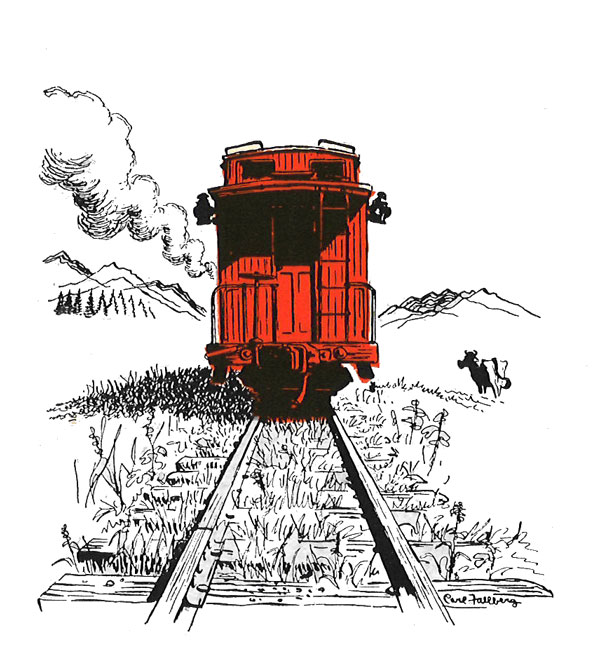 Who among us is not a railroader at heart? An editorial writer not long ago had this to say: "Among all the mechanical devices with which our generations have surrounded themselves and built the nation, the steam locomotive is the only one to have captured an almost universal affection." That affection is deep-seated and, perhaps, explains why the Silverton Branch carries thousands of passengers each summer season.
Who among us is not a railroader at heart? An editorial writer not long ago had this to say: "Among all the mechanical devices with which our generations have surrounded themselves and built the nation, the steam locomotive is the only one to have captured an almost universal affection." That affection is deep-seated and, perhaps, explains why the Silverton Branch carries thousands of passengers each summer season.
At any rate, the narrow gauge trip awakens fond memories for o generation while at the same time providing a graphic page from the past for today's youth. That vanishing breed, the steam locomotive, performs at its best, the aroma of coal smoke perfumes the atmosphere, the diminutive open-platform wooden coaches remind of an age long gone.
John B. Hungerford / Narrow Gauge to Silverton / Fourth Edition / 1958
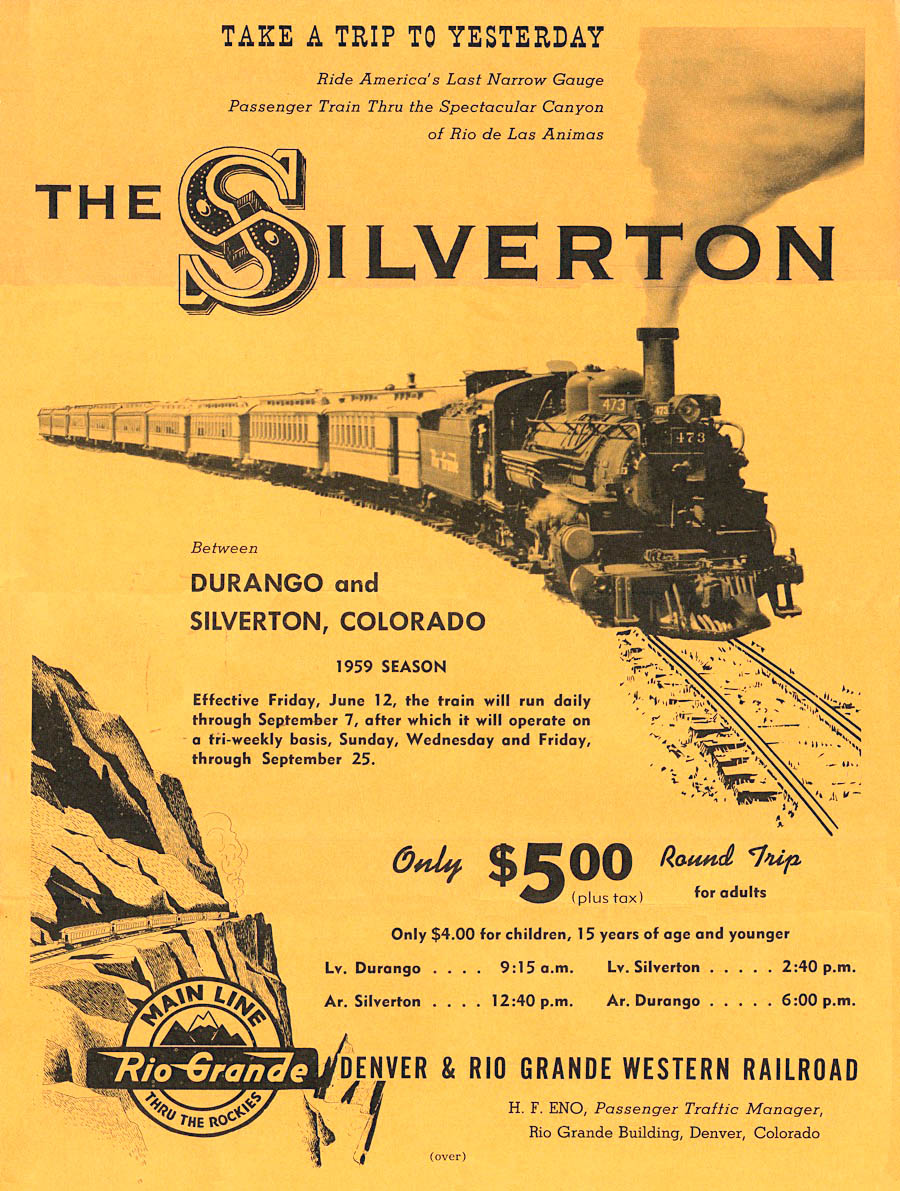
1959 Silverton flyer / collection
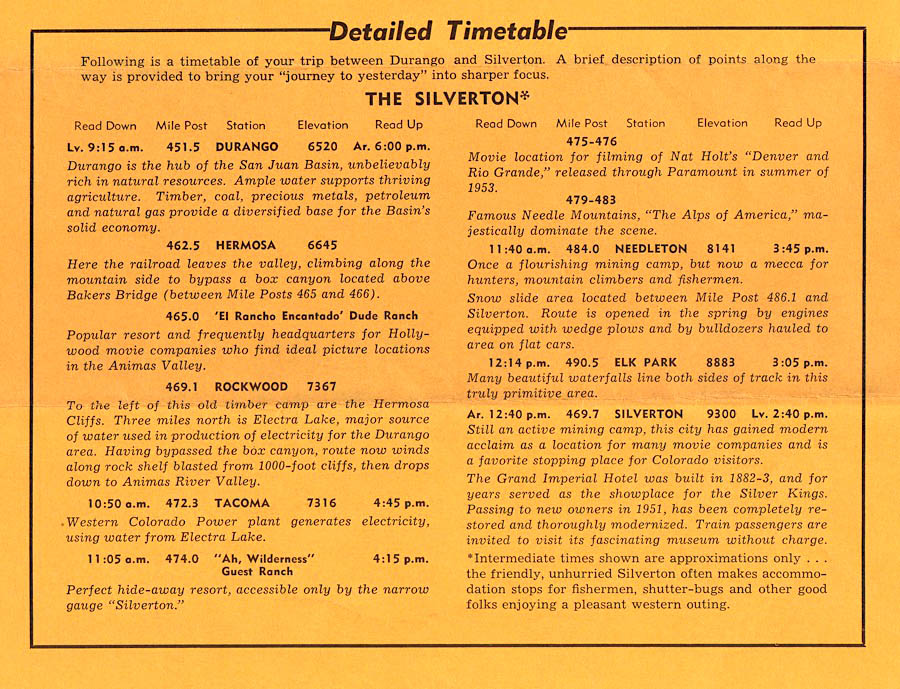
1959 Silverton flyer / collection

 by the 1920s Rio Grande had only two narrow gauge routes: from Salida west to Montrose via Marshall Pass, the original main line, then south to Ridgway and a connection with the Rio Grande Southern Railroad, which D&RG had controlled since 1893; and from Alamosa west to Durango. At Antonito the "Chili Line" branched south to Santa Fe, N. M.; at Durango branches headed for Farmington, N. M., and Silverton, and there was a second connection with the Rio Grande Southern. A narrow gauge line between Salida and Alamosa connected the two routes. It was possible to ride a complete circle on narrow gauge lines until a bus replaced the passenger trains on the Salida-Alamosa branch in the mid-1920s. The Chili Line was abandoned in 1942 for lack of traffic, and the narrow gauge circle was broken at Cerro Summit on the Marshall Pass route in 1949. The pace of narrow gauge abandonments accelerated (a few short segments were standard-gauged), so that by the mid-1950s only the Alamosa-Durango-Farmington-Silverton line was left, and it remained operational until 1967. Two segments of that route, from Antonito to Chama, NM, and from Durango to Silverton, survive as tourist lines.
by the 1920s Rio Grande had only two narrow gauge routes: from Salida west to Montrose via Marshall Pass, the original main line, then south to Ridgway and a connection with the Rio Grande Southern Railroad, which D&RG had controlled since 1893; and from Alamosa west to Durango. At Antonito the "Chili Line" branched south to Santa Fe, N. M.; at Durango branches headed for Farmington, N. M., and Silverton, and there was a second connection with the Rio Grande Southern. A narrow gauge line between Salida and Alamosa connected the two routes. It was possible to ride a complete circle on narrow gauge lines until a bus replaced the passenger trains on the Salida-Alamosa branch in the mid-1920s. The Chili Line was abandoned in 1942 for lack of traffic, and the narrow gauge circle was broken at Cerro Summit on the Marshall Pass route in 1949. The pace of narrow gauge abandonments accelerated (a few short segments were standard-gauged), so that by the mid-1950s only the Alamosa-Durango-Farmington-Silverton line was left, and it remained operational until 1967. Two segments of that route, from Antonito to Chama, NM, and from Durango to Silverton, survive as tourist lines.
The Historical Guide to North American Railroads - Second Edition
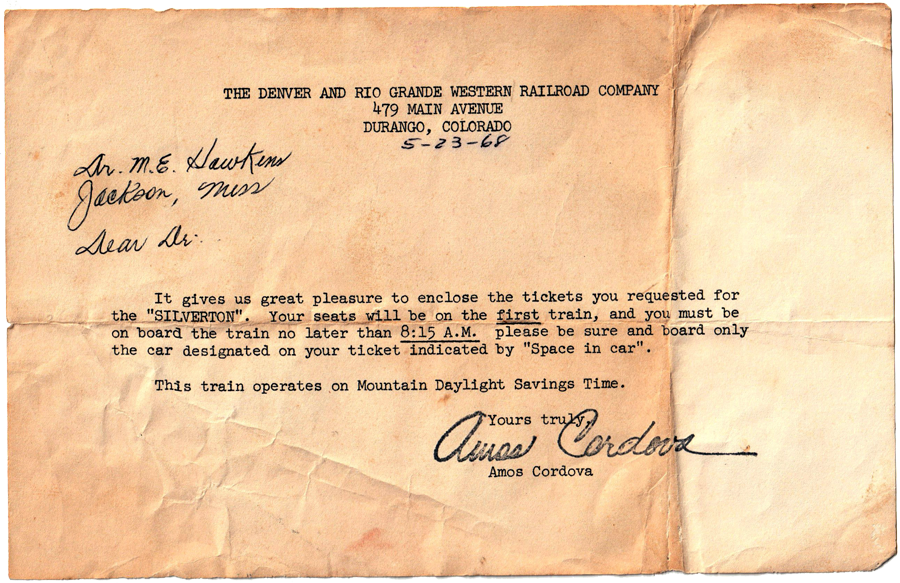
collection
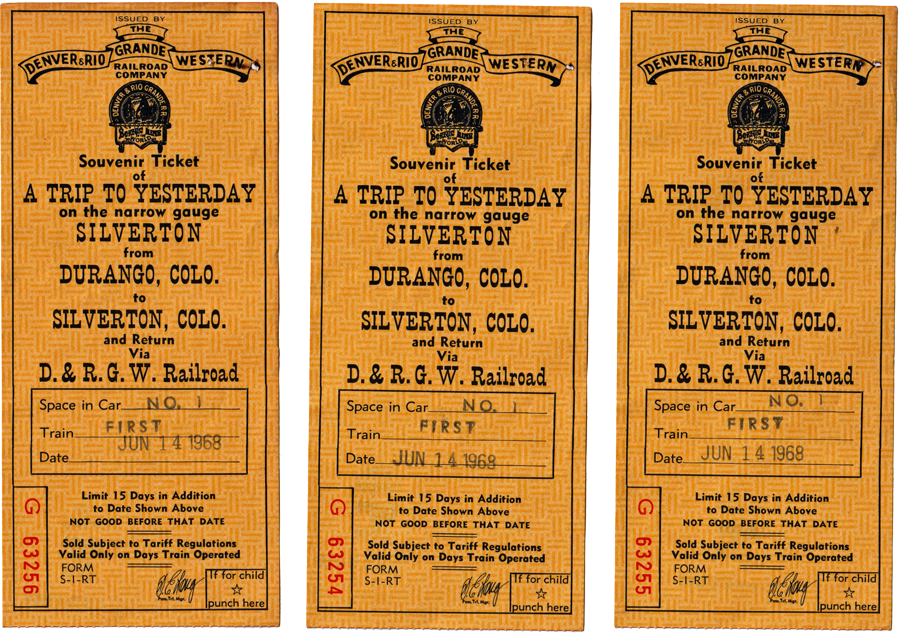
collection
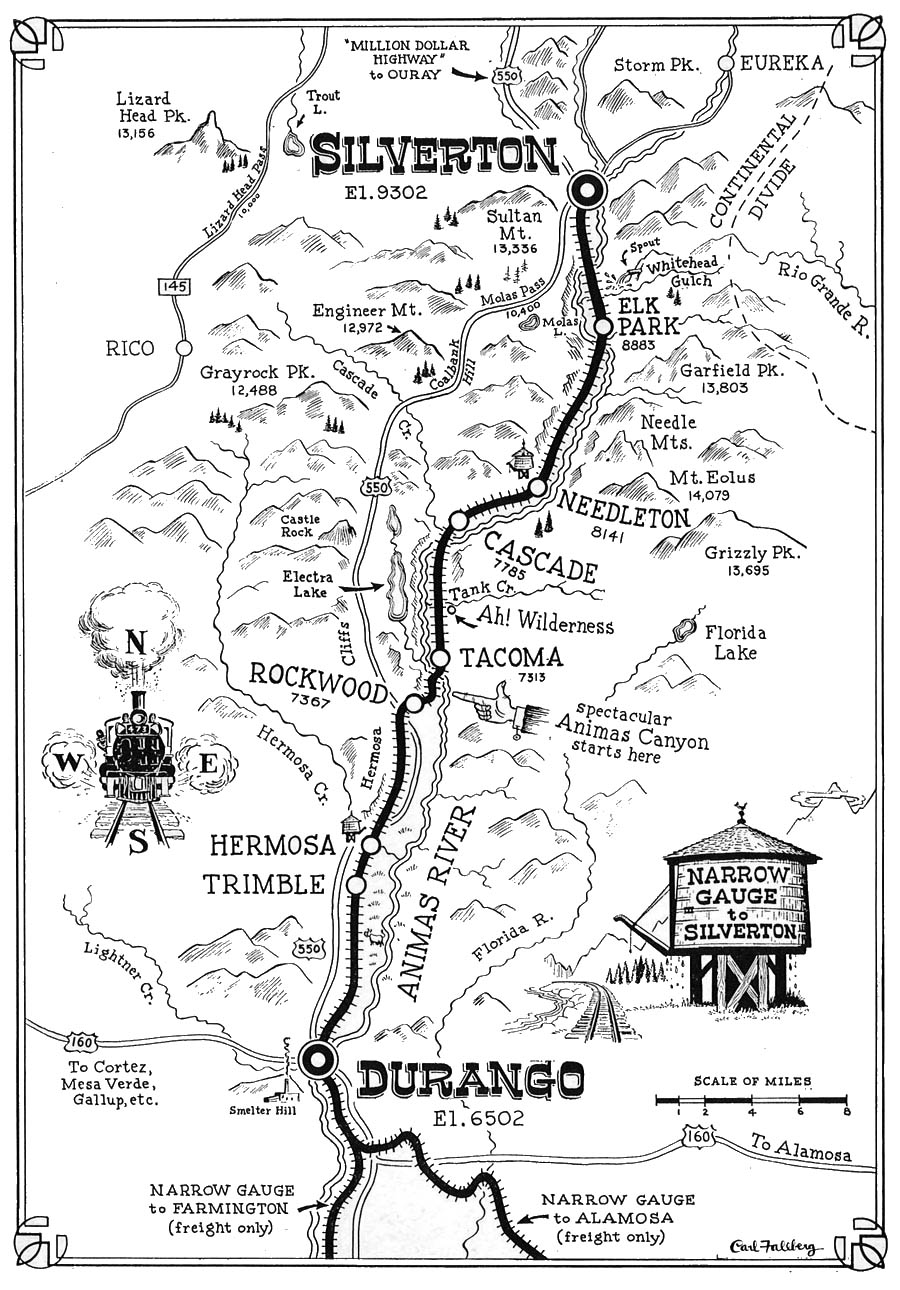
from Narrow Gauge to Silverton by John B. Hungerford / collection
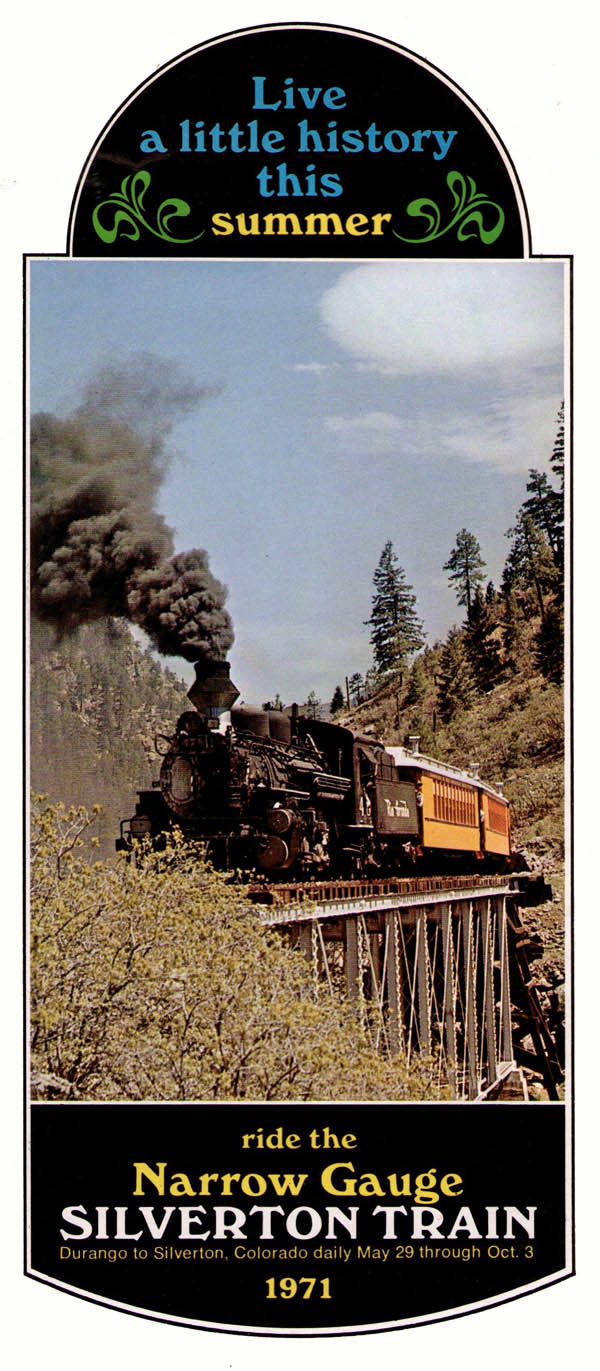
borchure / collection
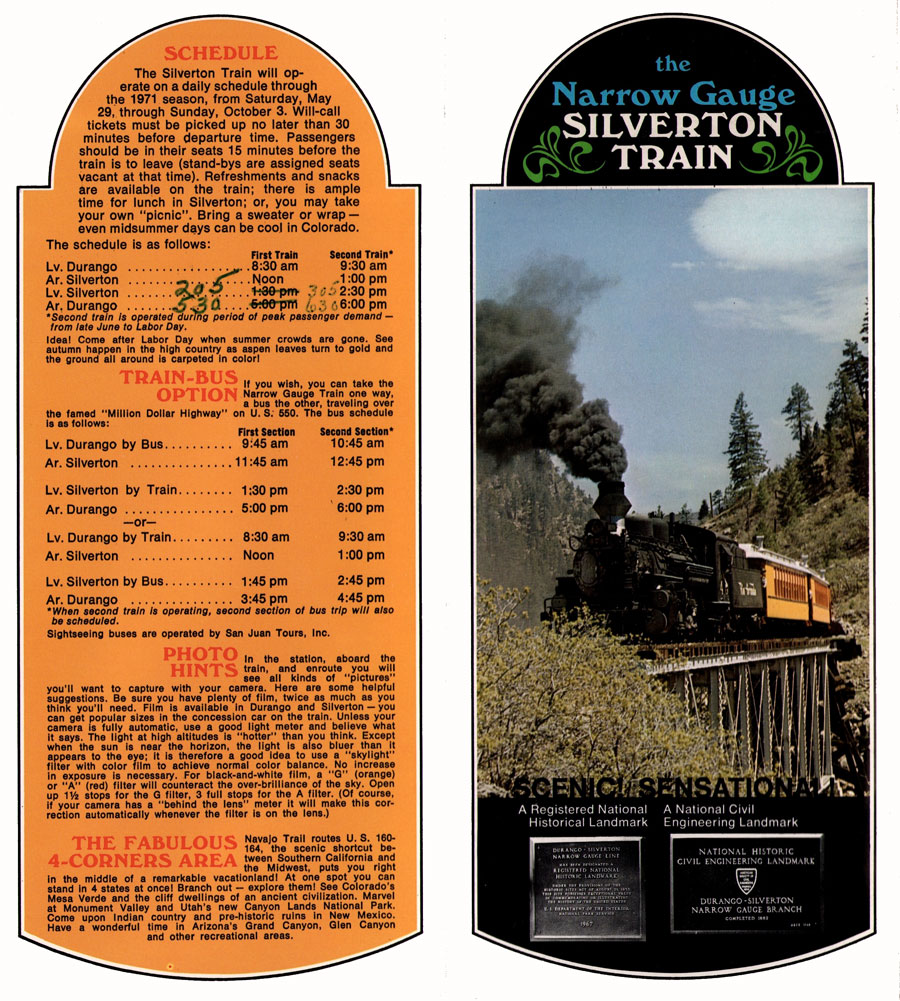
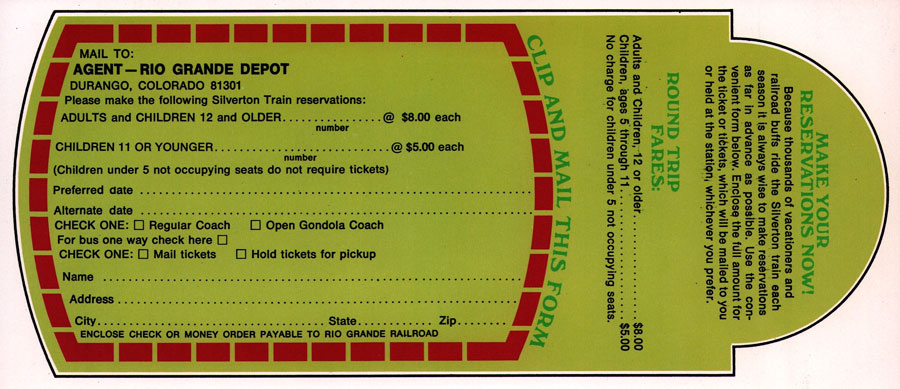
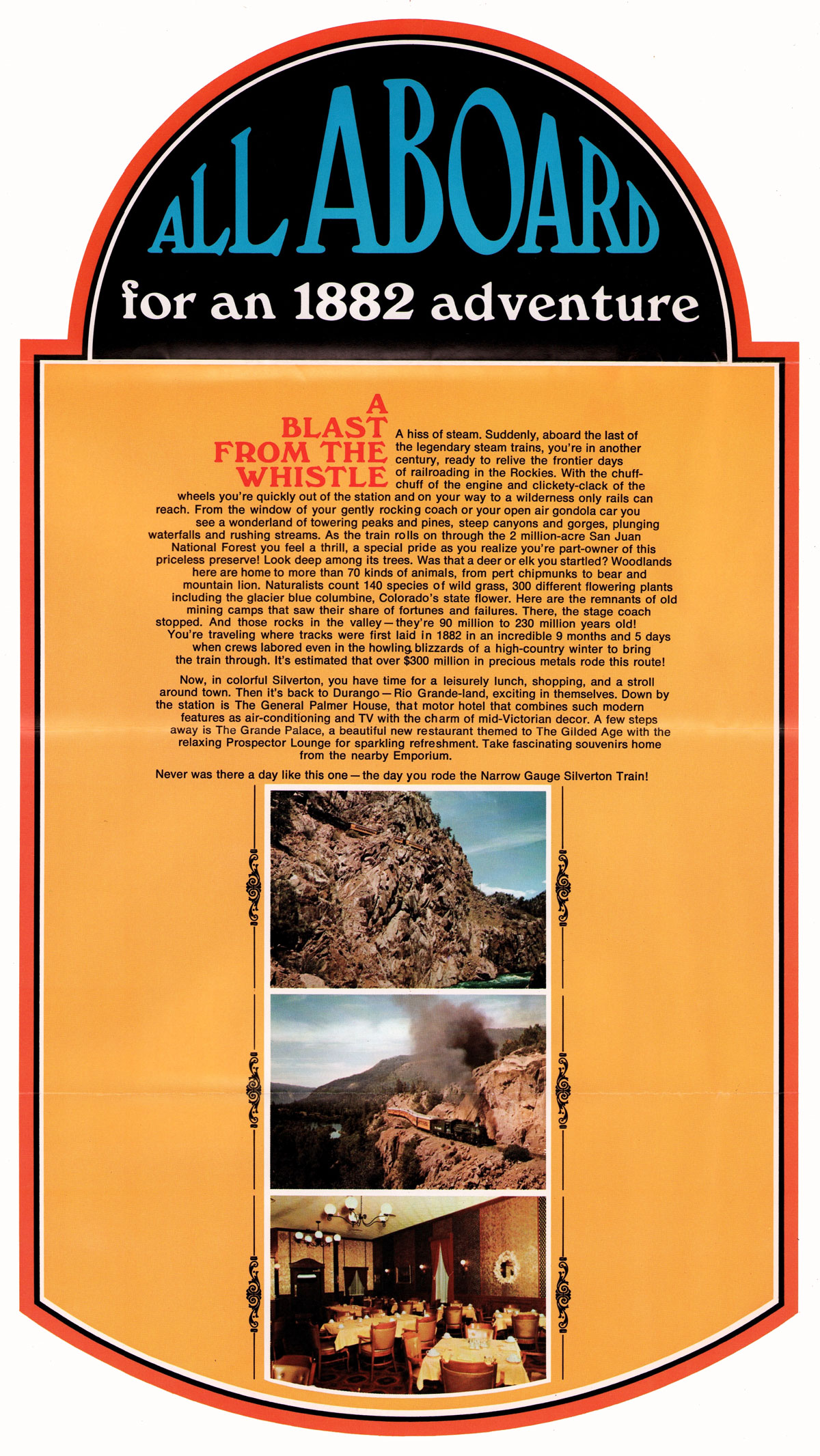
collection
 Durango
Durango


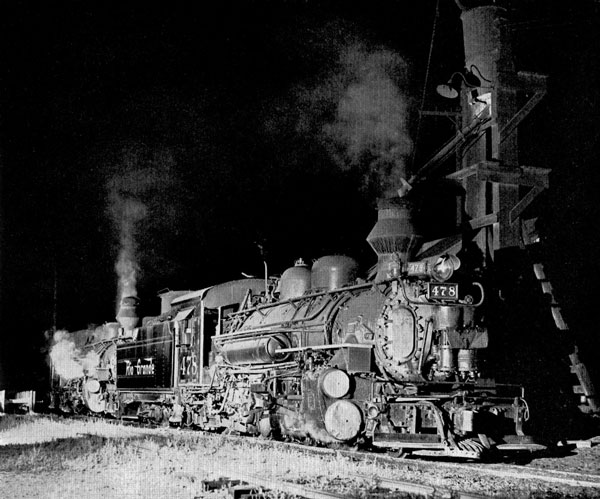
 n the days when the narrow gauge capital of the universe was Durango, its yards were the Mecca of the faithful to whom railroading is a major preoccupation regardless of hour or season. In the summer months of 1957 alone the Silverton train carried 25,000 passengers on the round trip up the Canyon of Animas for a gross revenue to the railroad in excess of $100,000 and immeasurably stimulated the economies of its terminals at Durango and Silverton where hotels, restaurants and tourism generally thrived on the excursionists attracted by the romantic narrow gauge.
n the days when the narrow gauge capital of the universe was Durango, its yards were the Mecca of the faithful to whom railroading is a major preoccupation regardless of hour or season. In the summer months of 1957 alone the Silverton train carried 25,000 passengers on the round trip up the Canyon of Animas for a gross revenue to the railroad in excess of $100,000 and immeasurably stimulated the economies of its terminals at Durango and Silverton where hotels, restaurants and tourism generally thrived on the excursionists attracted by the romantic narrow gauge.
Lucious Beebe & Charles Clegg / Narrow Gauge in the Rockies / 1958
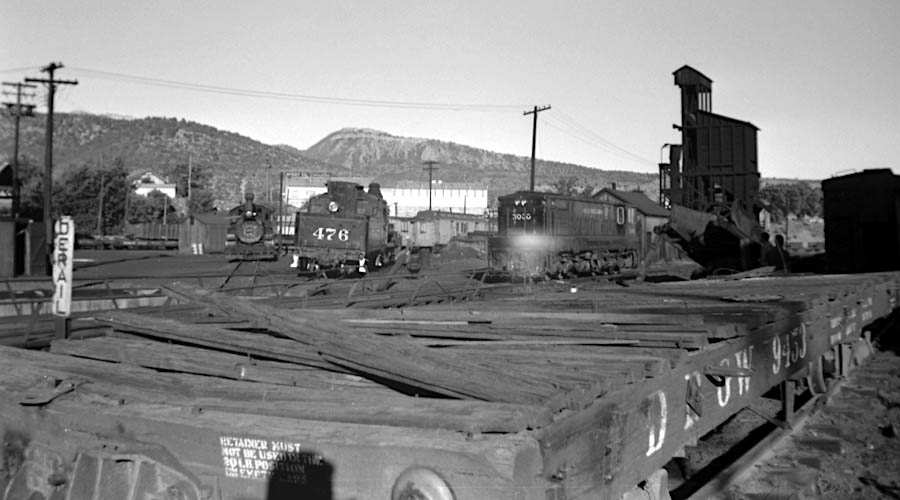
Durango, Co / Jun 1959 / JCH
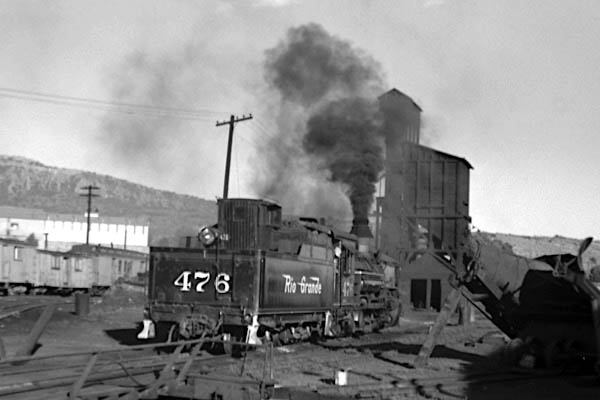
Durango, Co / Jun 1959 / JCH
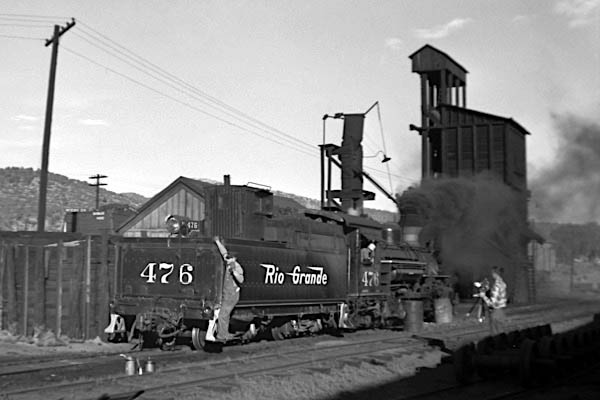
Durango, Co / Jun 1959 / JCH

Mining the San Juans
Large-scale mining began in the San Juan Mountains after the 1873 Brunot Agreement removed the Ute Indians from the area. The remote and rugged region had rich ores but limited transportation access, making the shipment of those ores slow and expensive. To tap this potentially lucrative market, in 1880 William Jackson Palmer’s Denver & Rio Grande Railway started to build the narrow gauge San Juan Extension west from the San Luis Valley. At the time, narrow gauge lines were relatively common in the Colorado mountains because they had rails that were only three feet apart, allowing for tighter curves, cheaper construction, and more efficient operation than the standard gauge of four feet, eight and a half inches. The railroad forged a route over Cumbres Pass to Chama, New Mexico, and then west through the Southern Ute Reservation to reach the Animas River, with the ultimate goal of reaching Silverton.
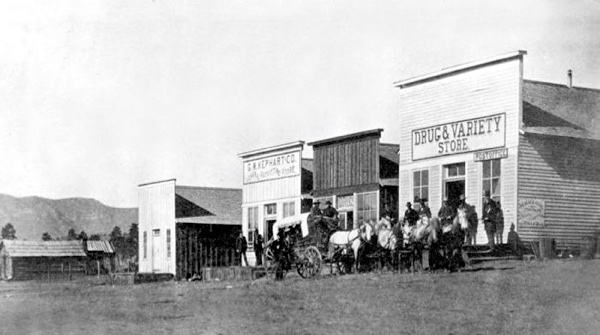 Originally the Denver & Rio Grande planned to have a station in Animas City, a small farming and ranching town that served as a supply depot for San Juan miners. When the railroad was approaching Animas City in 1880, however, the town rejected the railroad’s requests. Following a pattern that it had used elsewhere, the railroad decided to establish its own town, called Durango, two miles south of Animas City, and locate its station there. The town site was surveyed in September 1880. By the end of the year Durango had 2,000 residents—more than six times as many as Animas City, which became a small suburb of the booming railroad town until the two finally merged in 1948.
Originally the Denver & Rio Grande planned to have a station in Animas City, a small farming and ranching town that served as a supply depot for San Juan miners. When the railroad was approaching Animas City in 1880, however, the town rejected the railroad’s requests. Following a pattern that it had used elsewhere, the railroad decided to establish its own town, called Durango, two miles south of Animas City, and locate its station there. The town site was surveyed in September 1880. By the end of the year Durango had 2,000 residents—more than six times as many as Animas City, which became a small suburb of the booming railroad town until the two finally merged in 1948.
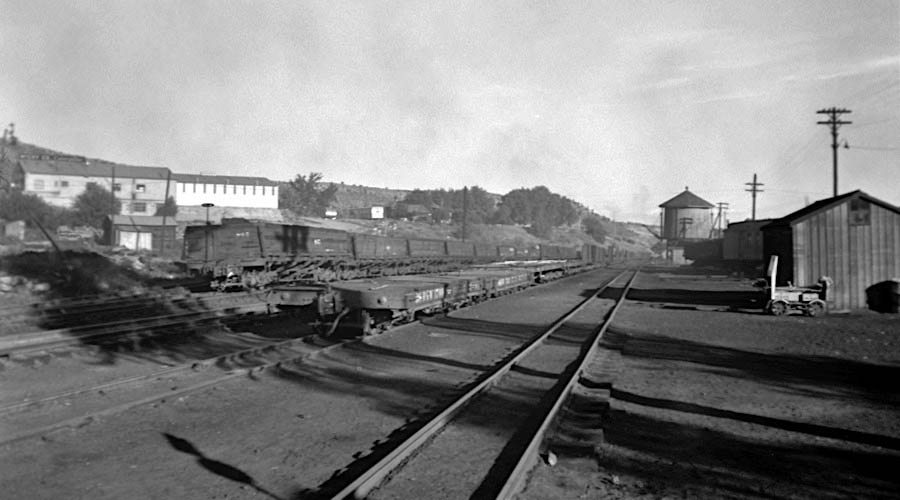
Durango, Co / Jun 1959 / JCH
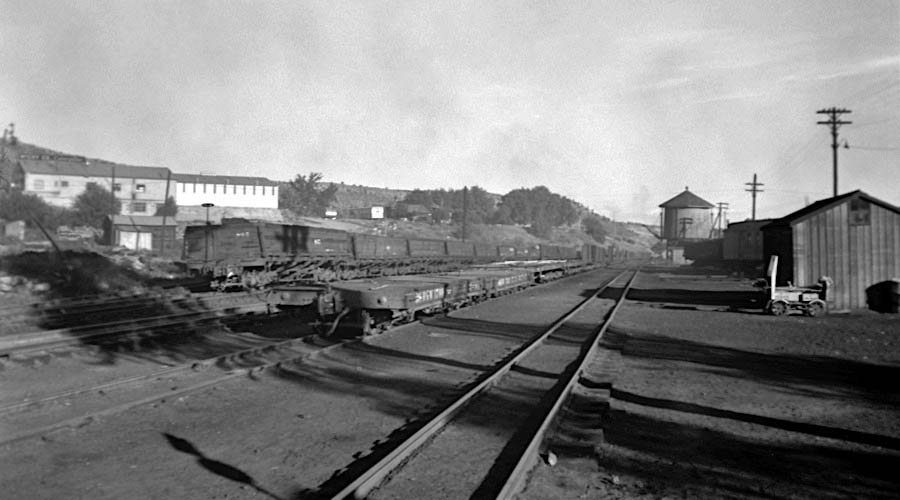
Durango, Co / Jun 1959 / JCH

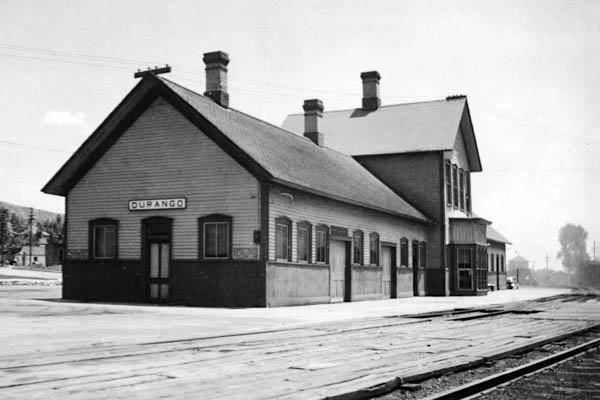
 he Silverton Branch of the Denver & Rio Grande was once part of an extensive network of three-foot-gauge railroads built to service the region's silver mines (hauling both workers and ore). In the mid-20th century, the system (some of which had been converted to standard gauge) began unraveling, until only two sections remained. Both are now tourist lines: the Cumbres & Toltec (owned by Colorado and New Mexico) and the privately owned portion called Durango & Silverton, which operates coal-fired steam trains (freight as well) through Colorado's San Juan Mountains. The Durango depot (1881) is essentially a long one-story building, broken in the center by a two-story cross gable. The upper portion was occupied at one time by the Rio Grande Southern. Covered in clap-boards, the station has simple pedimented window frames. The windows originally extended nearly to the floor, but most were shortened during the 1930s. The interior has been reconfigured for offices, rest rooms, and a gift shop. The current single waiting room was once divided into separate spaces for men and women.
he Silverton Branch of the Denver & Rio Grande was once part of an extensive network of three-foot-gauge railroads built to service the region's silver mines (hauling both workers and ore). In the mid-20th century, the system (some of which had been converted to standard gauge) began unraveling, until only two sections remained. Both are now tourist lines: the Cumbres & Toltec (owned by Colorado and New Mexico) and the privately owned portion called Durango & Silverton, which operates coal-fired steam trains (freight as well) through Colorado's San Juan Mountains. The Durango depot (1881) is essentially a long one-story building, broken in the center by a two-story cross gable. The upper portion was occupied at one time by the Rio Grande Southern. Covered in clap-boards, the station has simple pedimented window frames. The windows originally extended nearly to the floor, but most were shortened during the 1930s. The interior has been reconfigured for offices, rest rooms, and a gift shop. The current single waiting room was once divided into separate spaces for men and women.
Janet Greenstein Potter / Great American Railroads Stations / 1996

Click to see Durango plotted on a Google Maps page
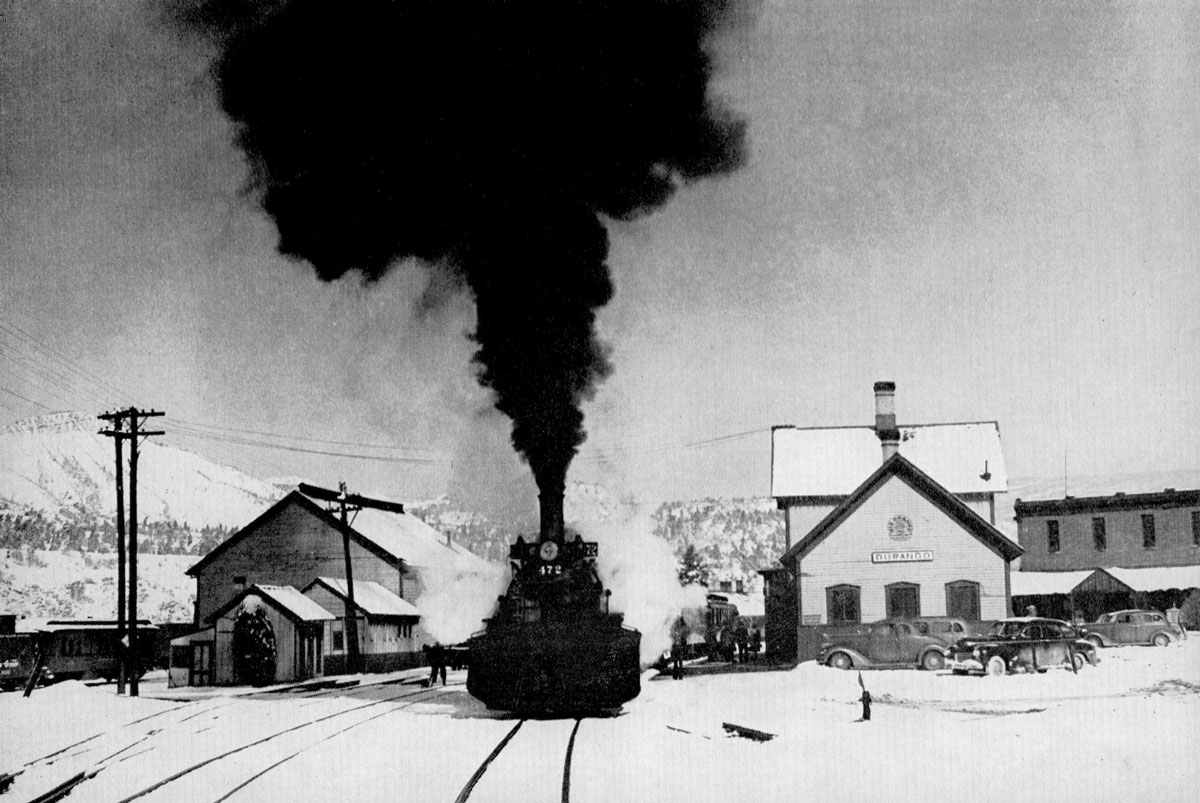
from Narrow Gauge in the Rockies by Lucius Beebe & Charles Clegg - 1958 / collection
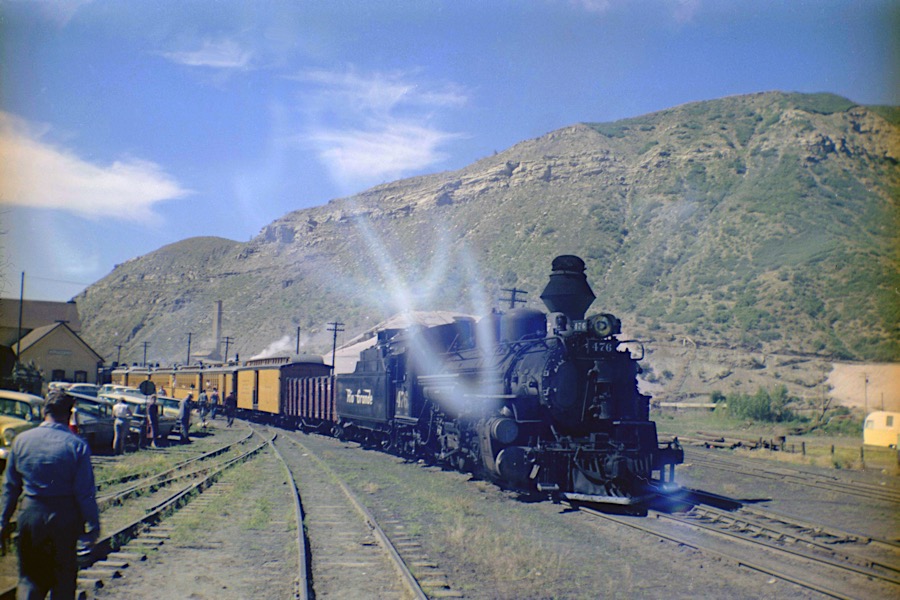
Durango, Co / Jun 1959 / JCH
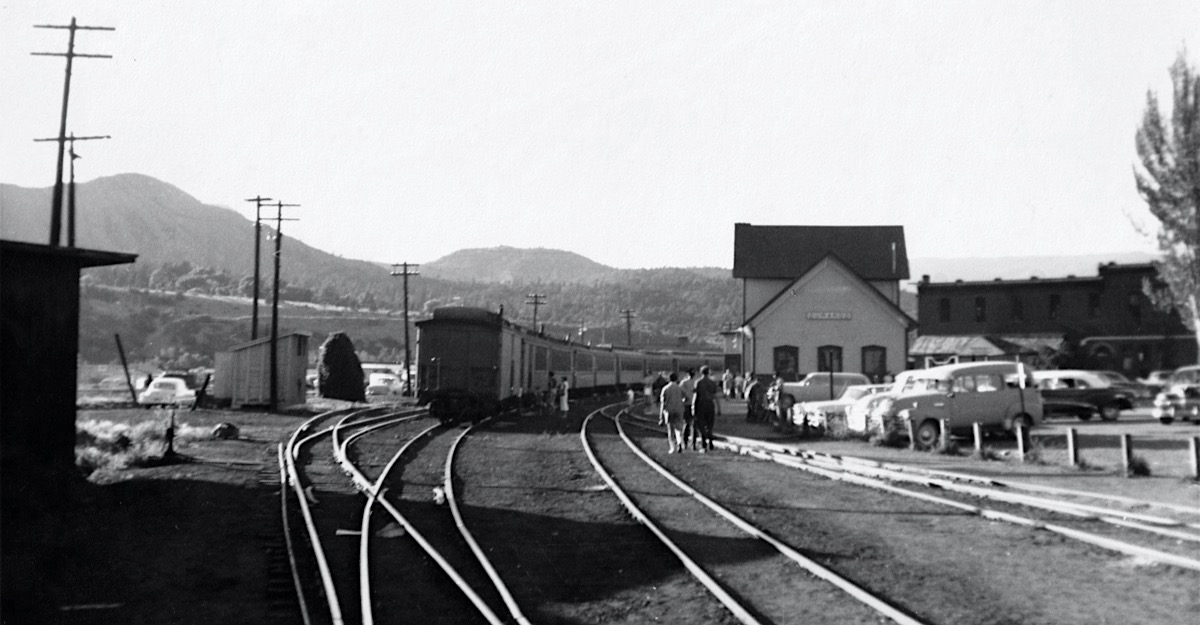
Durango, Co / Jun 1959 / JCH
 Along the Way
Along the Way
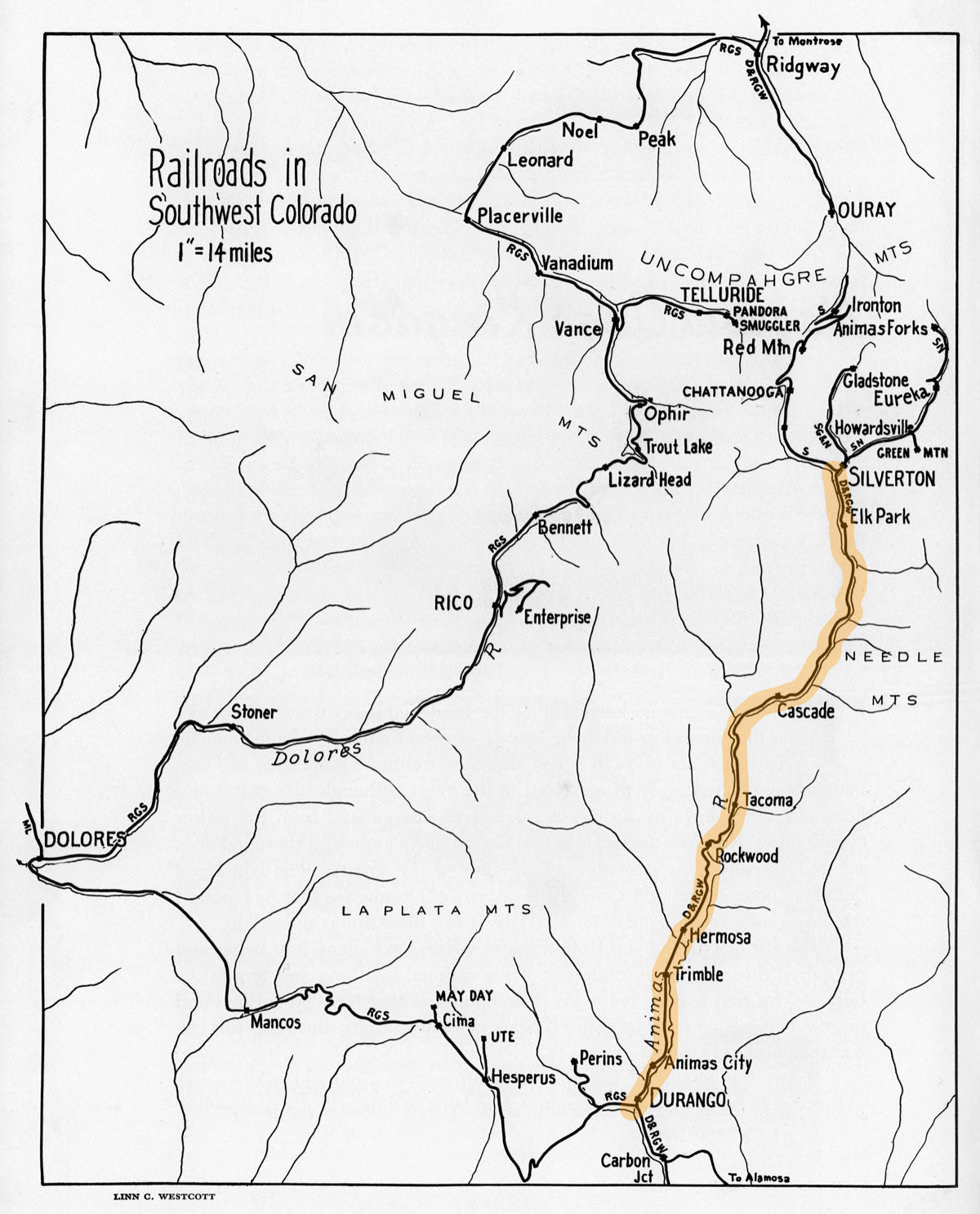
adapted from Mixed Train Daily: A Book of Short-Line Railroads by Lucius Beebe / collection

 he twice-a-week Durango-Silverton run over the iron of the Denver & Rio Grande Western through the canyon of the Rio de las Animas Perdidas is one of the last two scheduled narrow-gage passenger runs west of the Ohio River, the other being the Rio Grande's daily luxury passenger haul, the San Juan, each way between Durango and Alamosa.
he twice-a-week Durango-Silverton run over the iron of the Denver & Rio Grande Western through the canyon of the Rio de las Animas Perdidas is one of the last two scheduled narrow-gage passenger runs west of the Ohio River, the other being the Rio Grande's daily luxury passenger haul, the San Juan, each way between Durango and Alamosa.
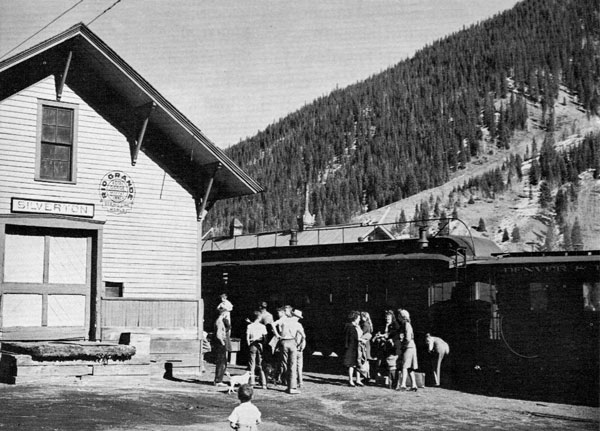 The Silverton train does not compare, when it is made up on Tuesday and Saturday mornings in the Durango yards, with the sleek green mail and bag. gage cars, coaches and parlor-restaurant-observation car of the glittering little San Juan, but for those on whose imaginations the romantic past of Western railroads has a wistful hold, it is no less of a page out of the chronicle of the silver legend of the Colorado pioneers. Usually Charlie Knight, senior conductor on the Silverton run, checks up on from a dozen to twenty freight cars, and the end of the little train is possessed of a sort of panache furnished by the Silverton coach and the crew's little red crummy.
The Silverton train does not compare, when it is made up on Tuesday and Saturday mornings in the Durango yards, with the sleek green mail and bag. gage cars, coaches and parlor-restaurant-observation car of the glittering little San Juan, but for those on whose imaginations the romantic past of Western railroads has a wistful hold, it is no less of a page out of the chronicle of the silver legend of the Colorado pioneers. Usually Charlie Knight, senior conductor on the Silverton run, checks up on from a dozen to twenty freight cars, and the end of the little train is possessed of a sort of panache furnished by the Silverton coach and the crew's little red crummy.
The Silverton coach itself is a museum piece dating as it does from 1882, with its ornate brass coal-oil lamp fixtures, cannon ball stove in the corner, comfortable leather seats and railed-in rear platform. It has travelled an unrecorded number of thousands of miles through hot summer noontides and in the deadly blizzards of the Colorado winters and always it has come back to the yards at Durango a little richer for one more footnote to the chapter of the narrow gage.
Lucius Beebe / Mixed Train Daily: A Book of Short-Line Railroads / 1961
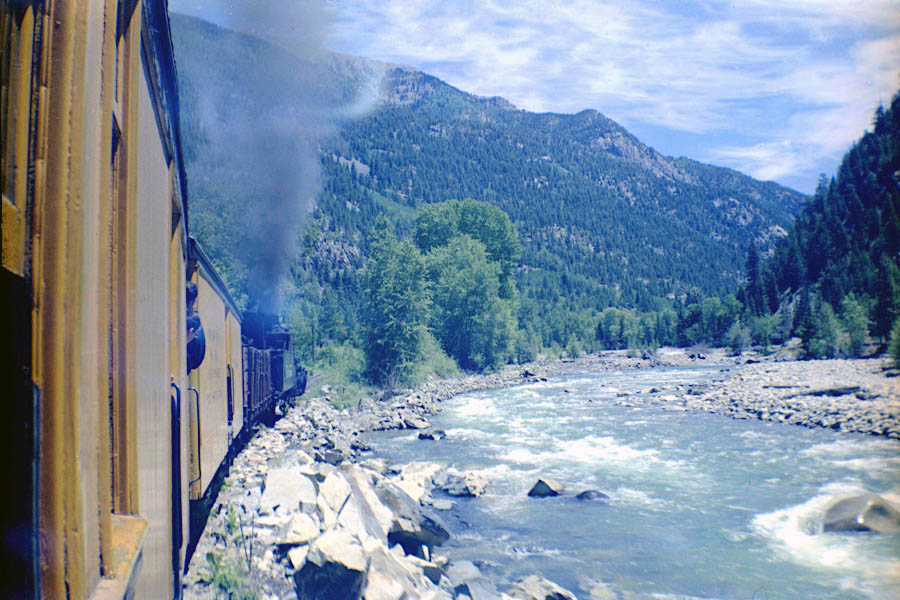
Needleton, Co / Jun 1959 / JCH
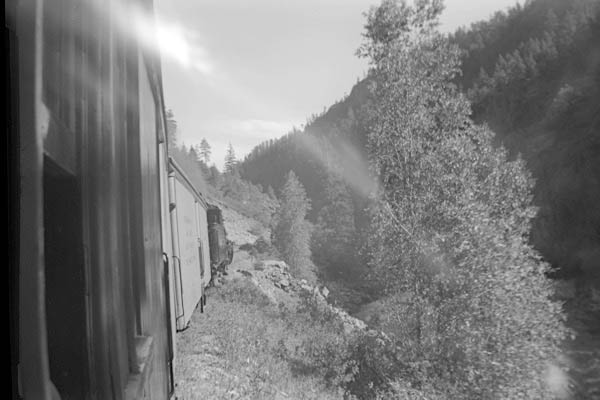
Needleton, Co / Jun 1959 / JCH
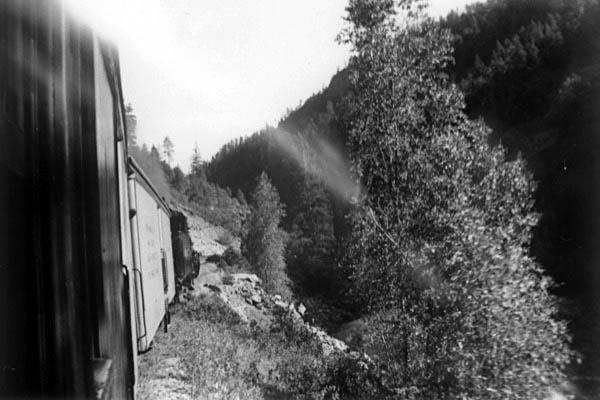
Needleton, Co / Jun 1959 / JCH
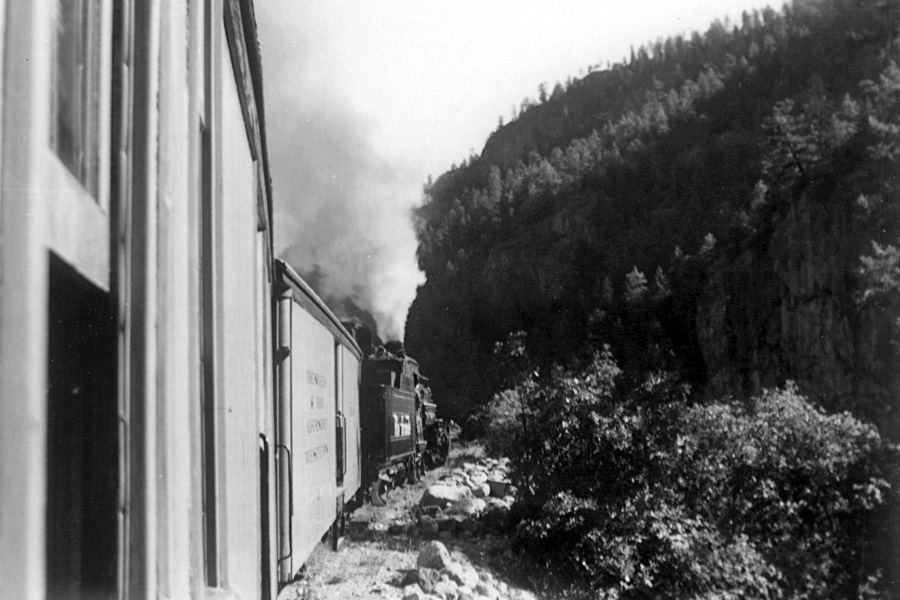
Needleton, Co / Jun 1959 / JCH
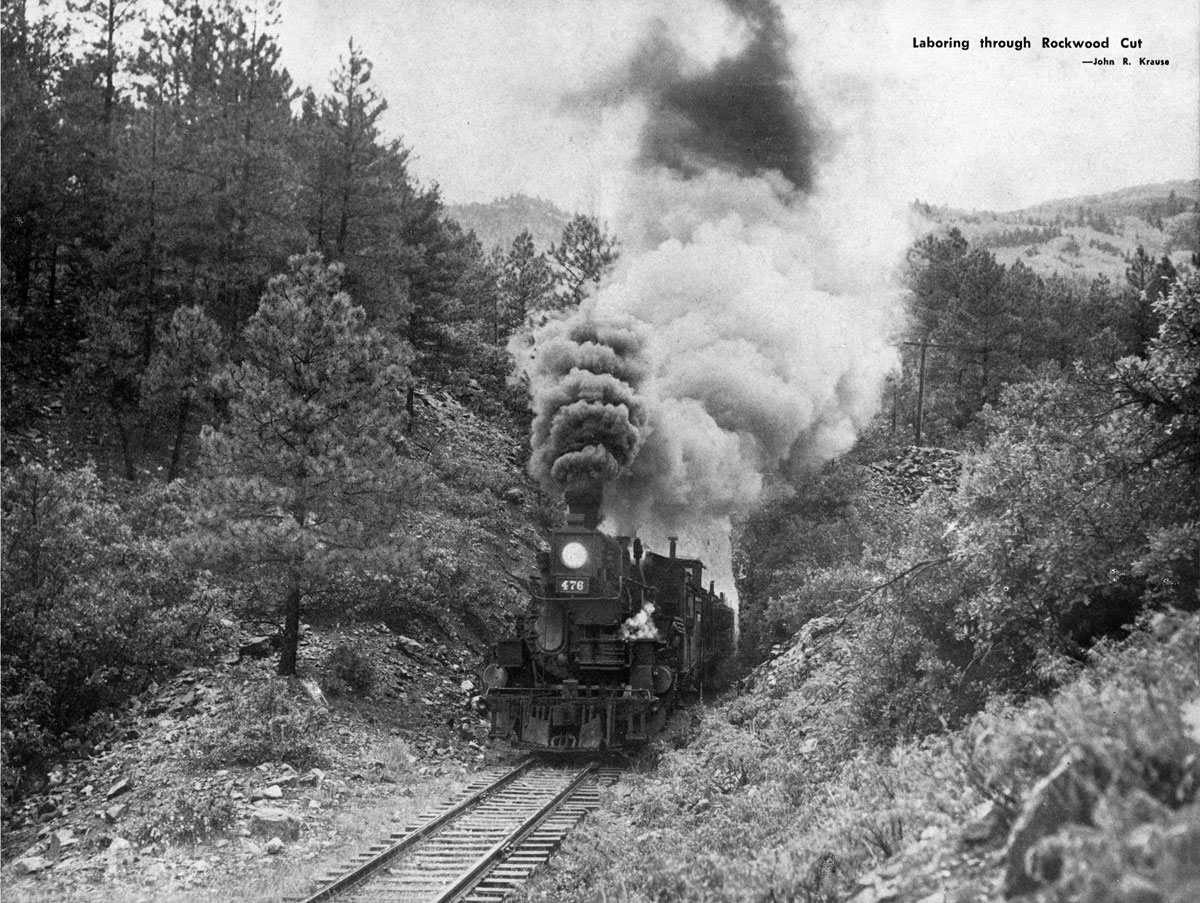
from Narrow Gauge to Silverton by John B. Hungerford / collection

Building from Durango to Silverton
In July 1881, the Denver & Rio Grande reached Durango and almost immediately started building the final forty-five-mile stretch up the Animas River to Silverton. The railroad had already acquired the Animas Canyon Toll Road, built a few years earlier to connect Animas City to Silverton, and used parts of the road for its route. Grading started in August, and by October track was being laid north from Durango. The first eighteen miles to Rockwood were relatively easy and had been completed by late November.
After Rockwood, however, the route left the wide valley and entered the steep, narrow Animas Canyon, making construction more difficult. It was also more expensive, with costs reportedly reaching tens of thousands of dollars per mile. In some places the crew had to blast the canyon walls to create a narrow rock shelf for the tracks. With 500 mostly Chinese and Irish workers rushing to complete the line, the grading operations reached Silverton in late spring 1882.
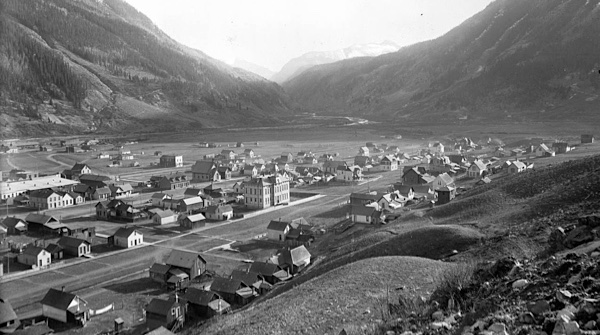 Silverton eagerly anticipated its rail connection to the outside world, which promised to inaugurate a long boom in the local mining economy. On June 27, 1882, Silverton residents heard their first train whistle from a work train about three and a half miles away. A large celebration to welcome the railroad was held on July 4, even though the rails still fell two miles short of their goal. The first construction train finally rolled into Silverton on July 8, passenger service started on July 11, and trains hauled their first ore on July 13, less than a year after work on the line started in Durango.
Silverton eagerly anticipated its rail connection to the outside world, which promised to inaugurate a long boom in the local mining economy. On June 27, 1882, Silverton residents heard their first train whistle from a work train about three and a half miles away. A large celebration to welcome the railroad was held on July 4, even though the rails still fell two miles short of their goal. The first construction train finally rolled into Silverton on July 8, passenger service started on July 11, and trains hauled their first ore on July 13, less than a year after work on the line started in Durango.
 Silverton
Silverton
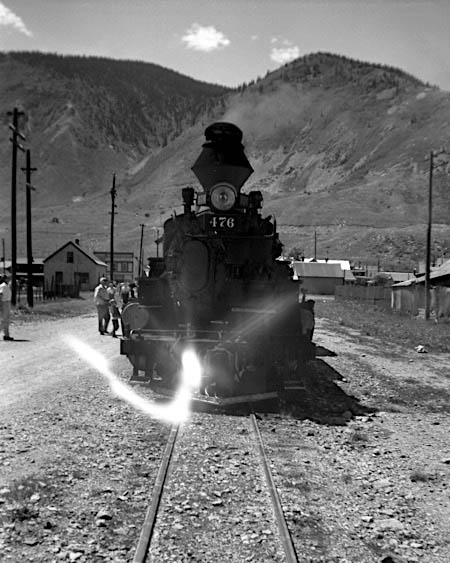
Jun 1959 / JCH

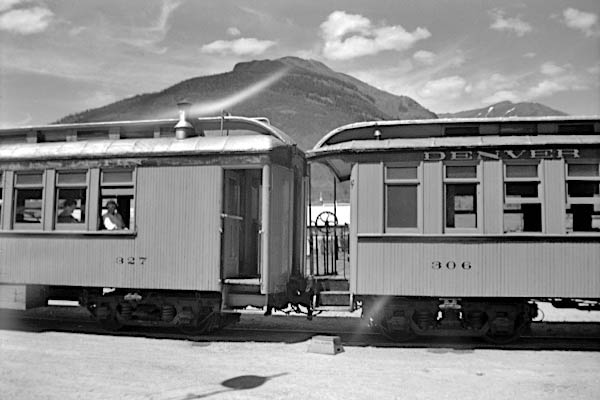
Silverton, Co / Jun 1959 / JCH

Click to see Silverton plotted on a Google Maps page
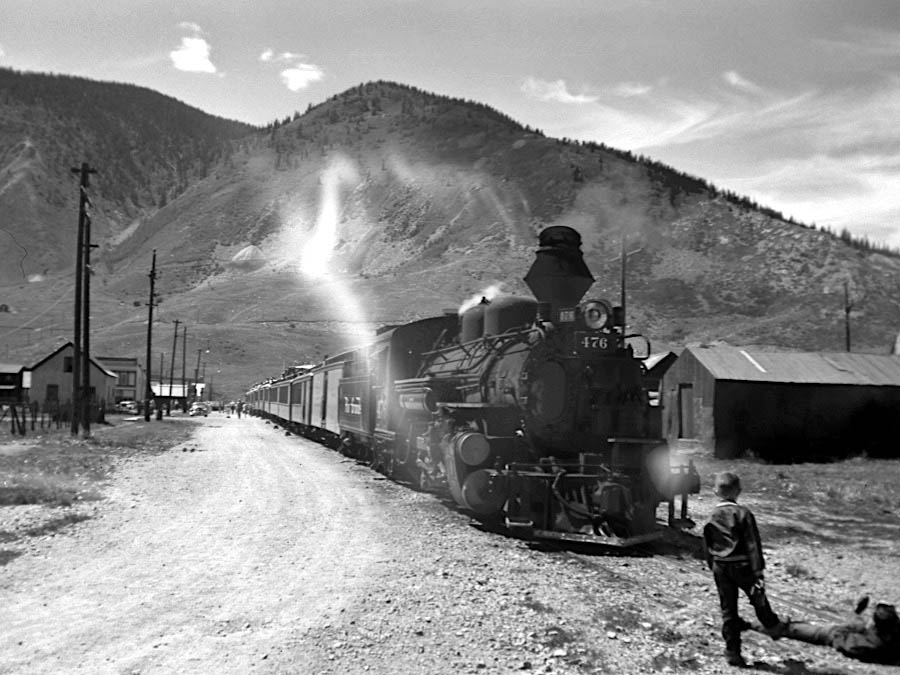
Silverton, Co / Jun 1959 / JCH
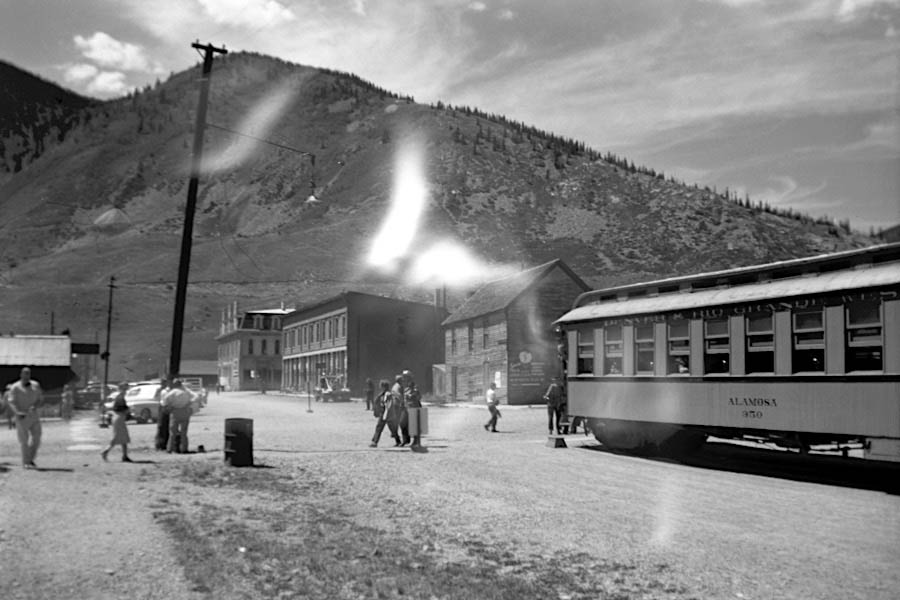
Silverton, Co / Jun 1959 / JCH

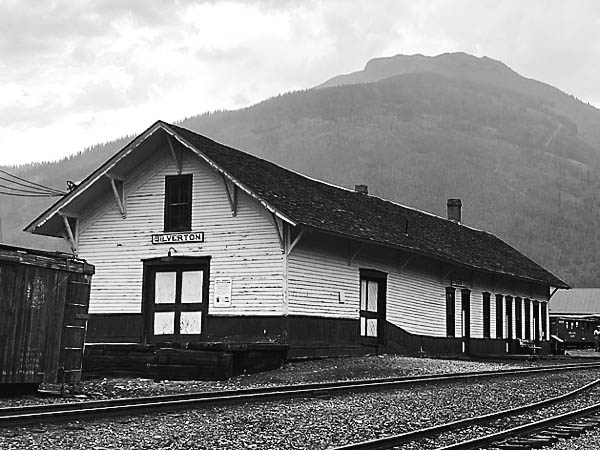
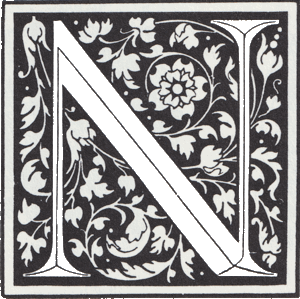 ot a ghost town, Silverton is still substantial enough to afford the visitor an idea of its former importance. It survives as an incorporated town and the county seat of San Juan County, a section so rugged that not an acre of farm land exists within its boundaries. Elegant homes once lined some of the streets that today are empty, but the main business street remains largely intact. It could well be a movie set from the 1880 era. When the boom was on, the Silverton district was a roarin' camp of 10,000 population, but the number has dwindled to fewer than 1500 today. For a score of years Silverton was a major railroad center, with three other short lines stretching out to the north. Two, the Silverton Railroad and the Silverton Northern, were built by Mears and the third, the Silverton, Gladstone & Northerly, eventually came under his ownership. All three at one time maintained passenger service,although the longest railroad never exceeded 17 miles. Even so, they were vital adjuncts to the mines. The year the Denver & Rio Grande built into Silverton — 1882 — $20 million in gold and silver came from the nearby mines, it is said.
ot a ghost town, Silverton is still substantial enough to afford the visitor an idea of its former importance. It survives as an incorporated town and the county seat of San Juan County, a section so rugged that not an acre of farm land exists within its boundaries. Elegant homes once lined some of the streets that today are empty, but the main business street remains largely intact. It could well be a movie set from the 1880 era. When the boom was on, the Silverton district was a roarin' camp of 10,000 population, but the number has dwindled to fewer than 1500 today. For a score of years Silverton was a major railroad center, with three other short lines stretching out to the north. Two, the Silverton Railroad and the Silverton Northern, were built by Mears and the third, the Silverton, Gladstone & Northerly, eventually came under his ownership. All three at one time maintained passenger service,although the longest railroad never exceeded 17 miles. Even so, they were vital adjuncts to the mines. The year the Denver & Rio Grande built into Silverton — 1882 — $20 million in gold and silver came from the nearby mines, it is said.
John B. Hungerford / Narrow Gauge to Silverton / 1958
 8mm movie
8mm movie
"Mixed Train to Silverton"
Jun 1959 / JCH
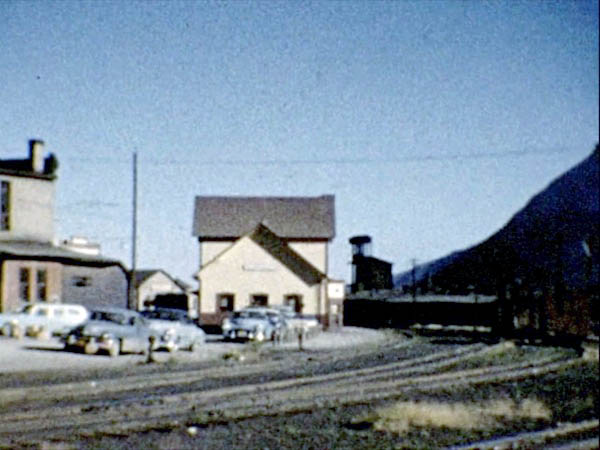
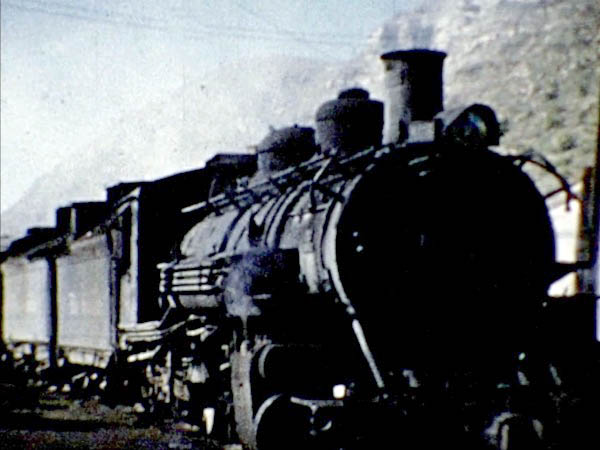
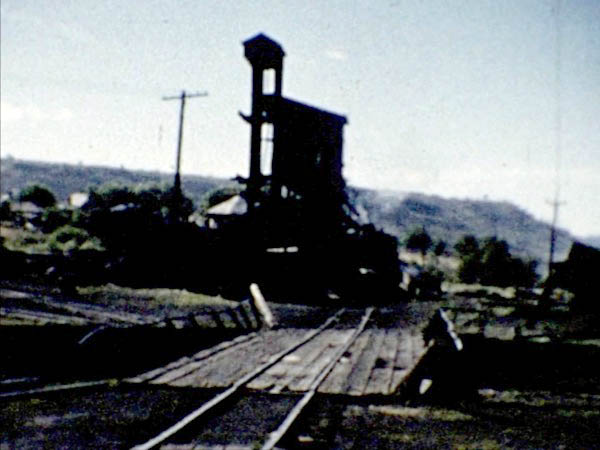
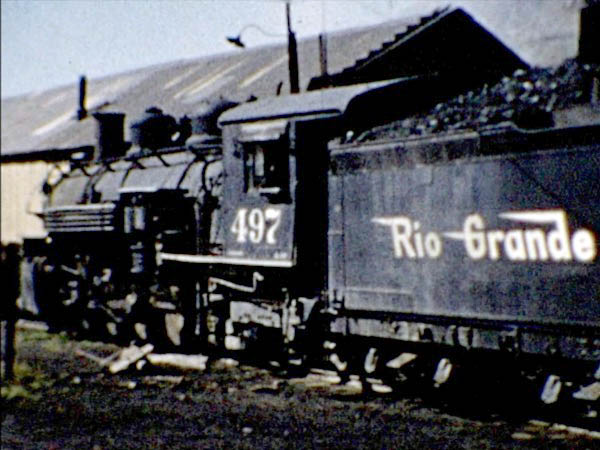
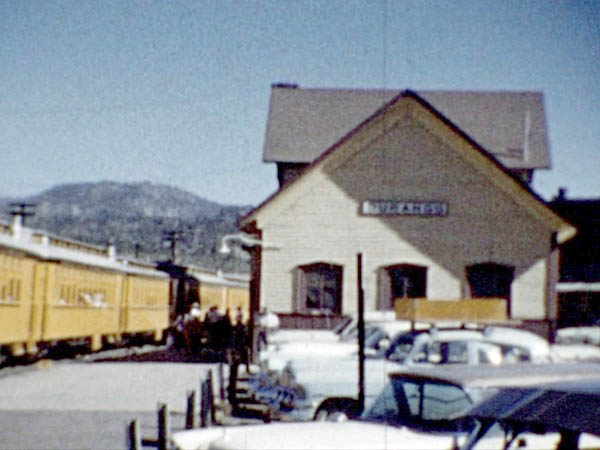
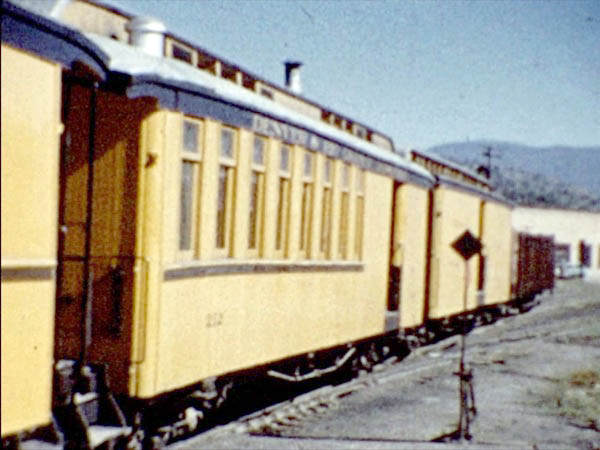
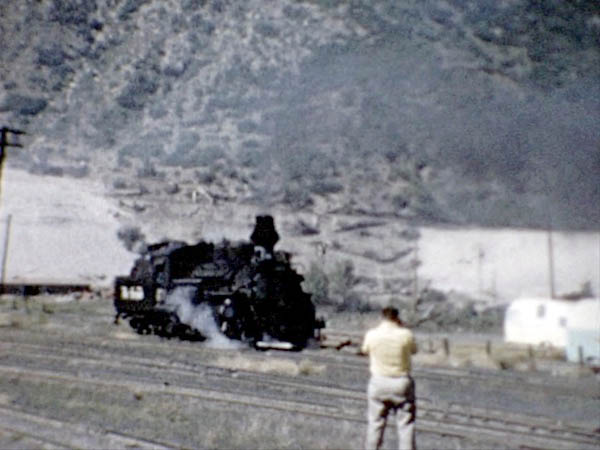
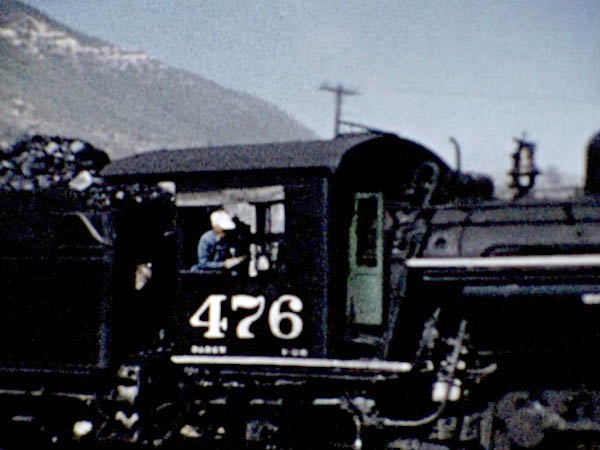
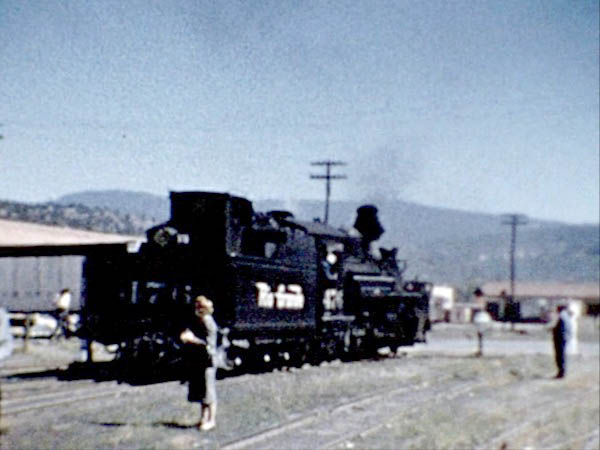
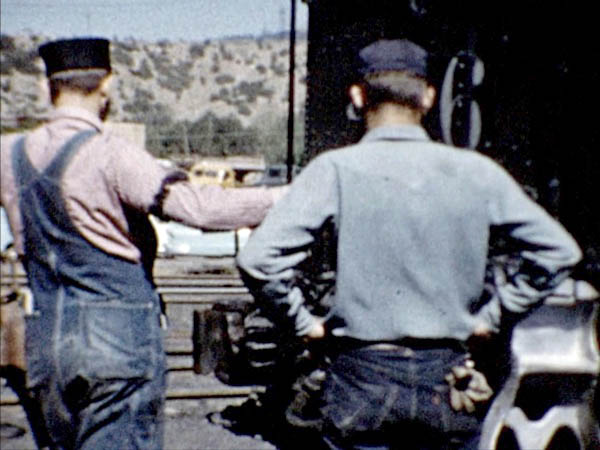
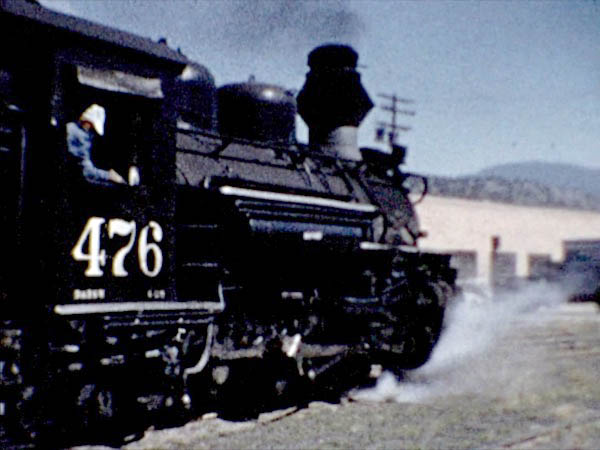
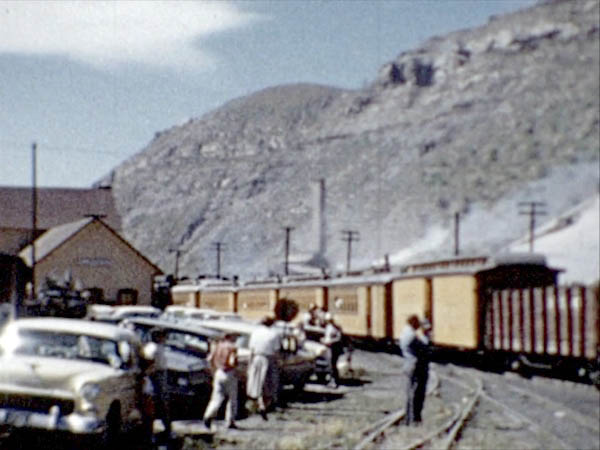
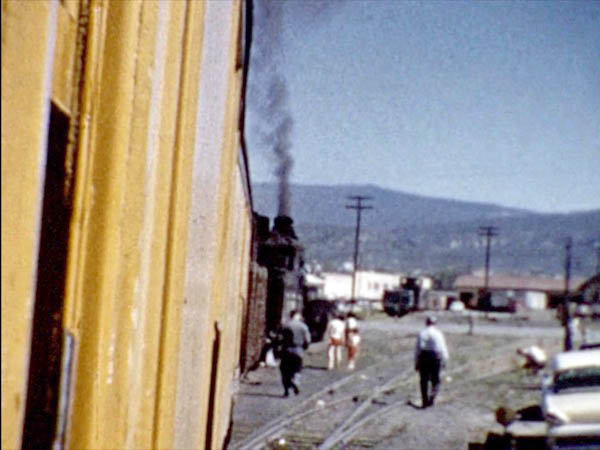
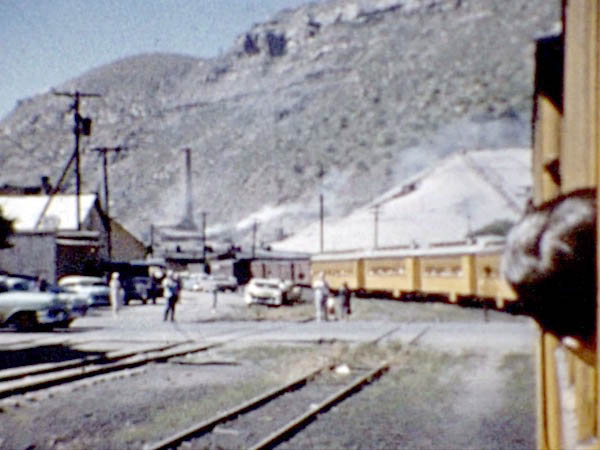
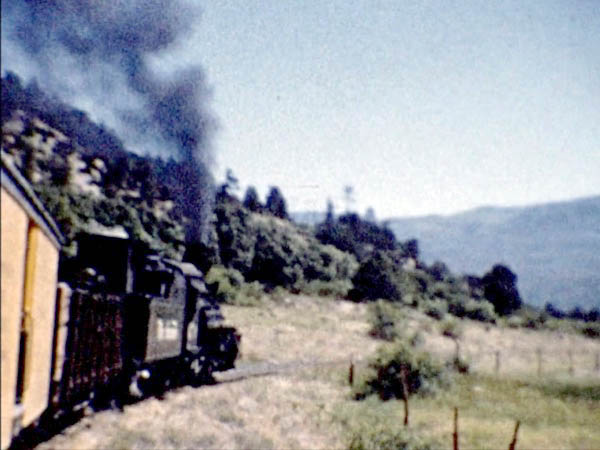
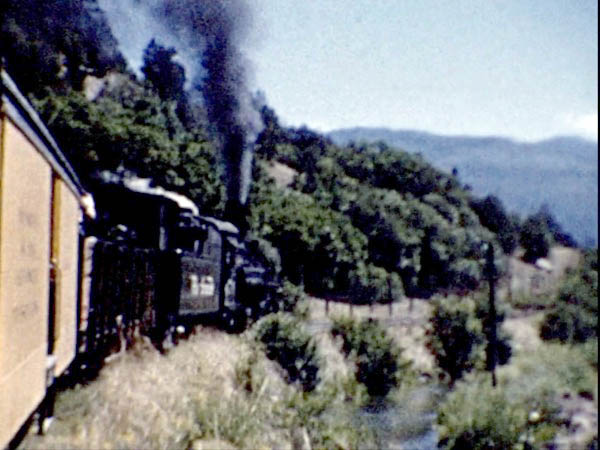
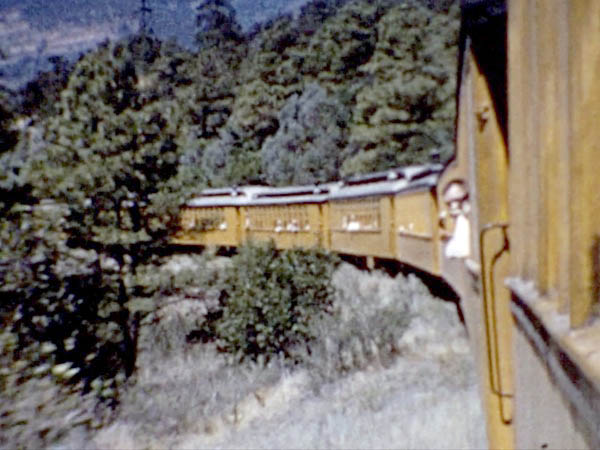
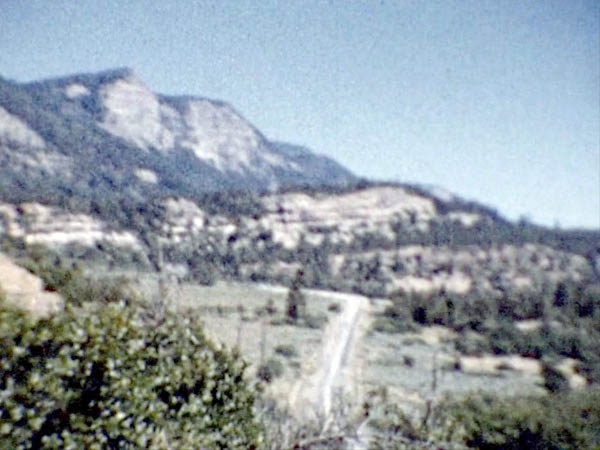
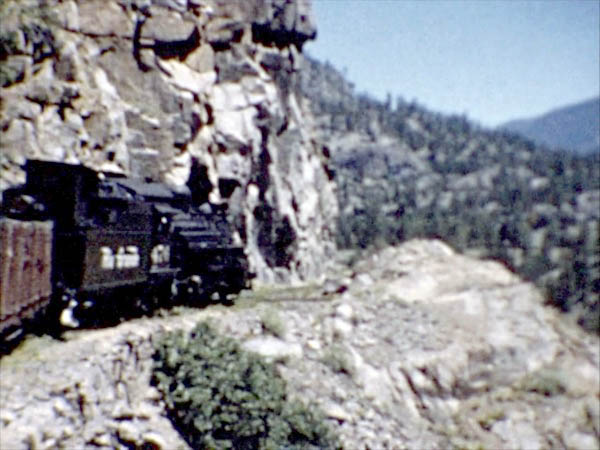
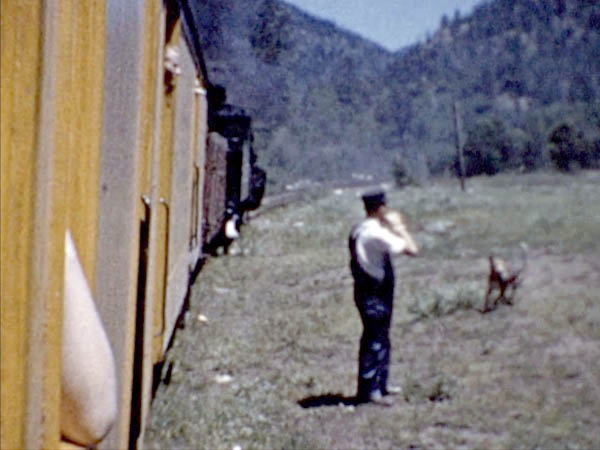
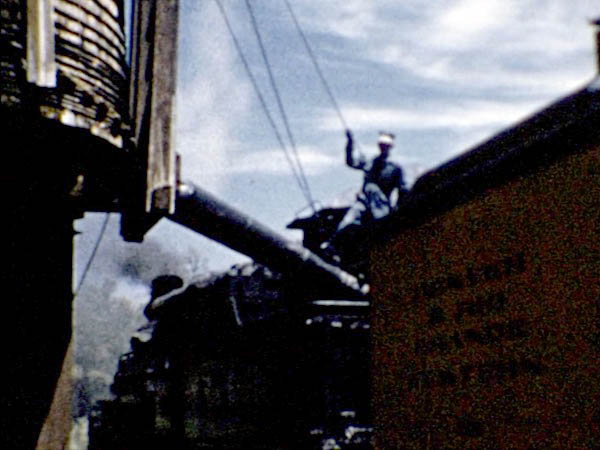
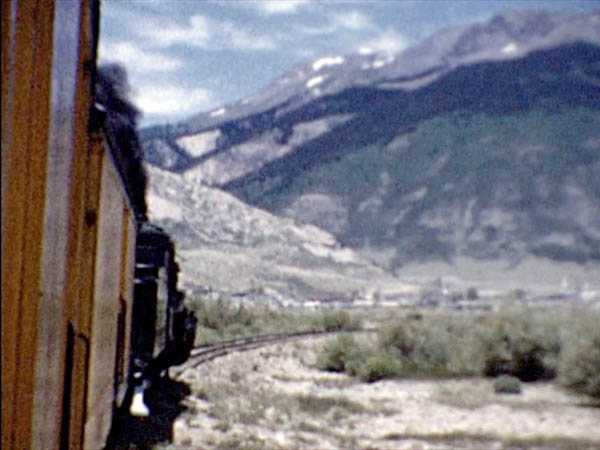
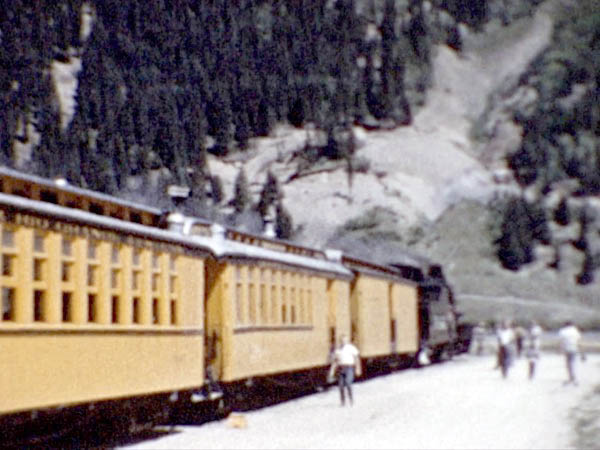
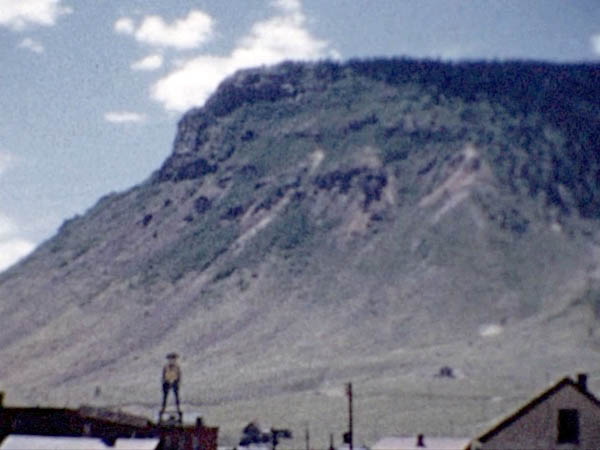
Jun 1959 / JCH
 Clippings
Clippings
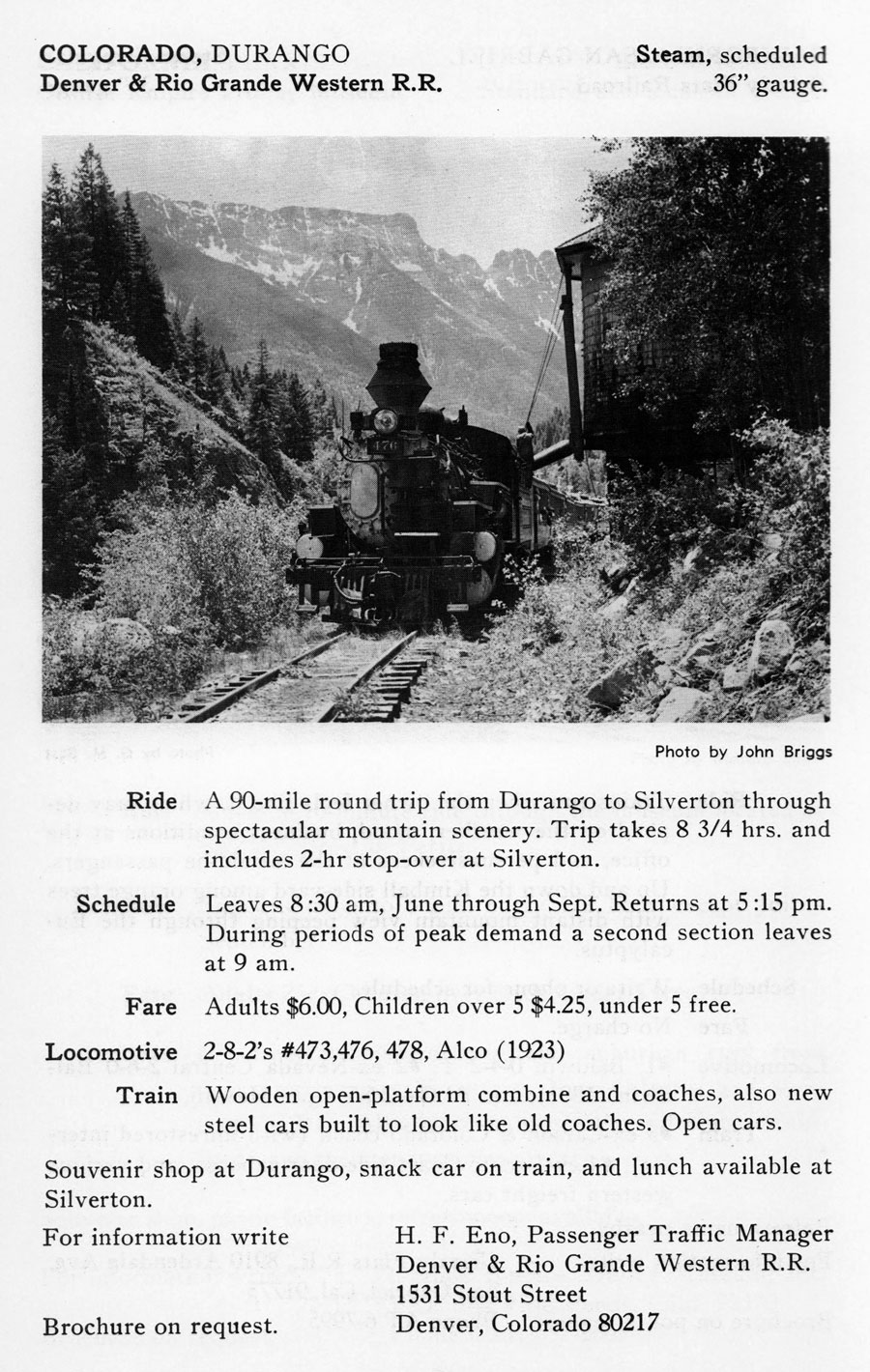
1966 tourist train guide ad / collection
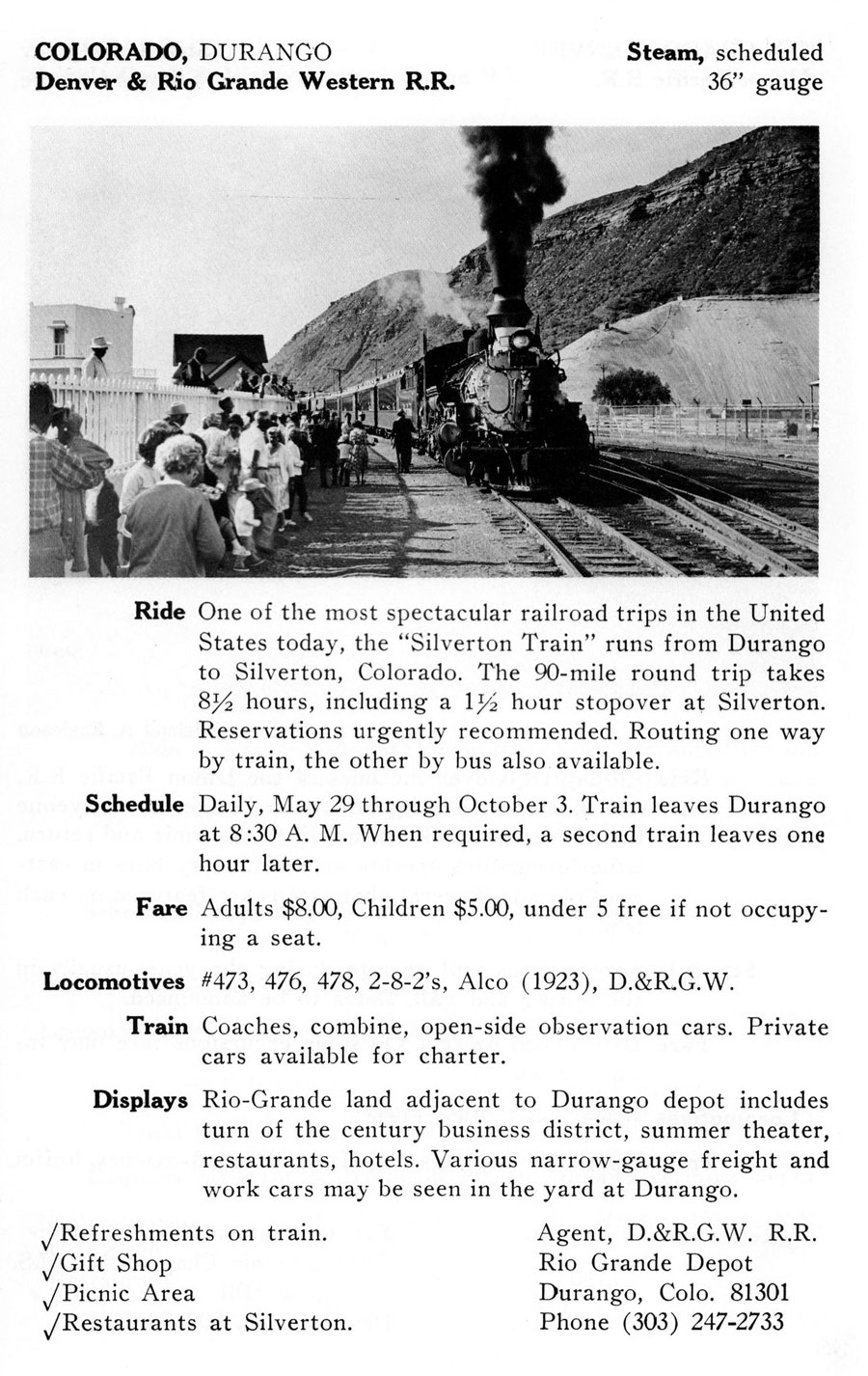
1971 tourist train guide ad / collection
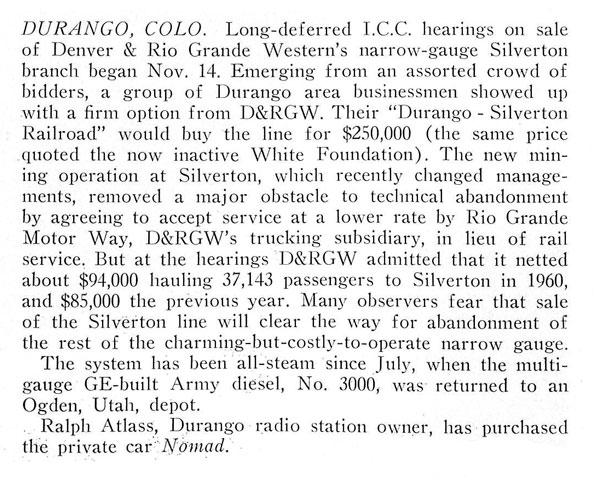
from Steam Locomotive & Railroad Tradition 6 - Dec 1960 / collection
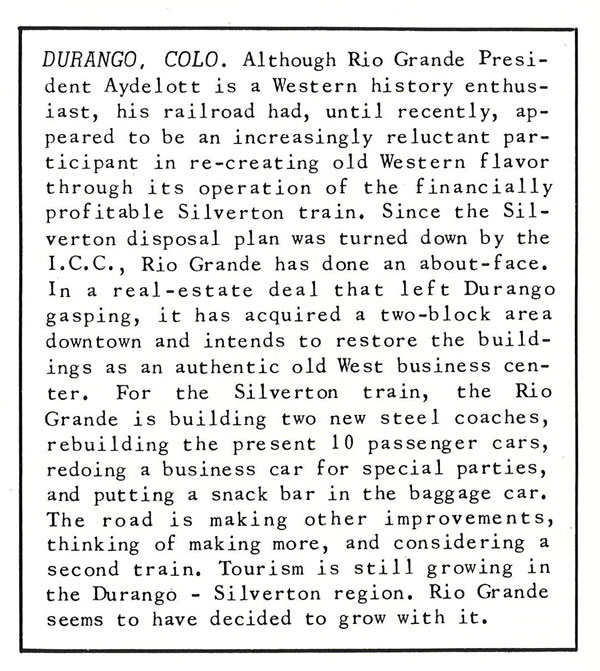
from Steam Locomotive & Railroad Tradition 13 - May 1963 / collection

from Railroading magazine - Oct 1968 / collection
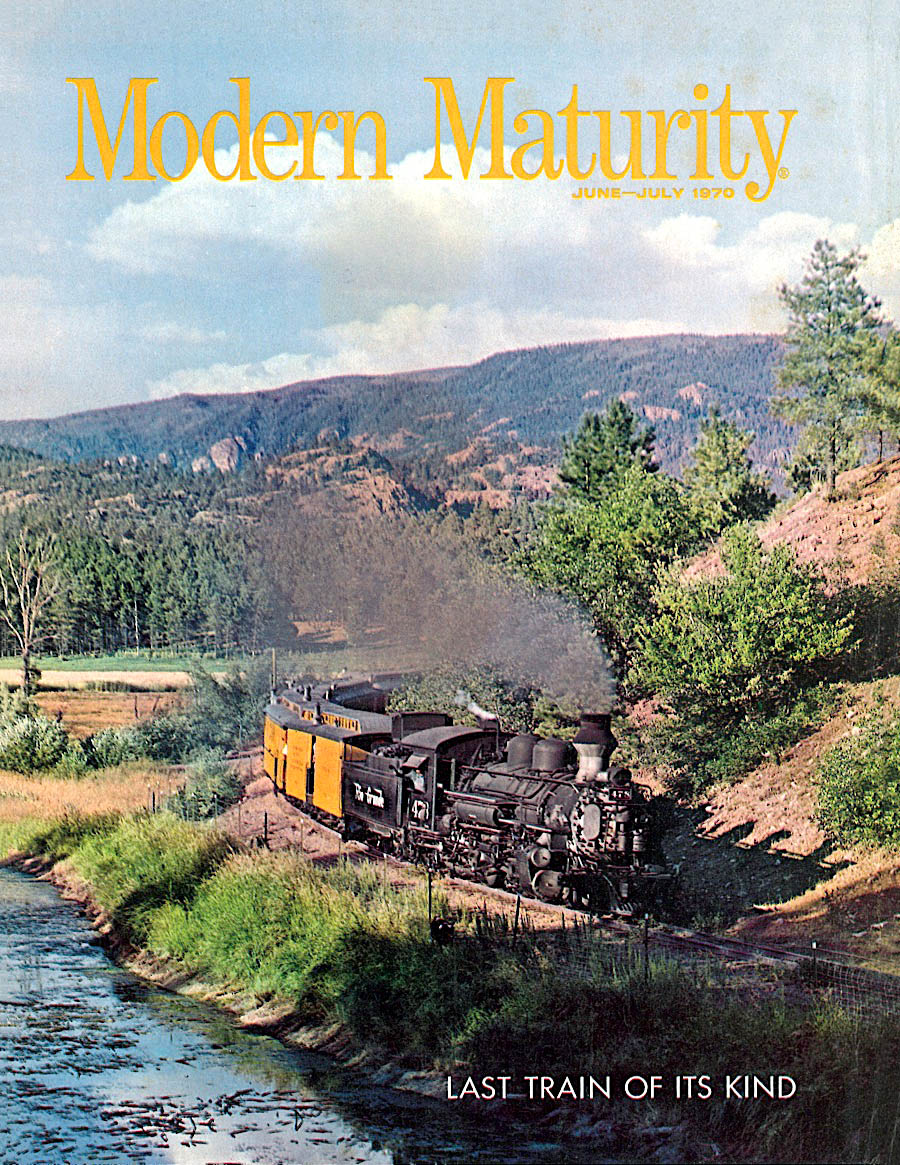
from Modern Maturity magazine - Jun 1970 collection
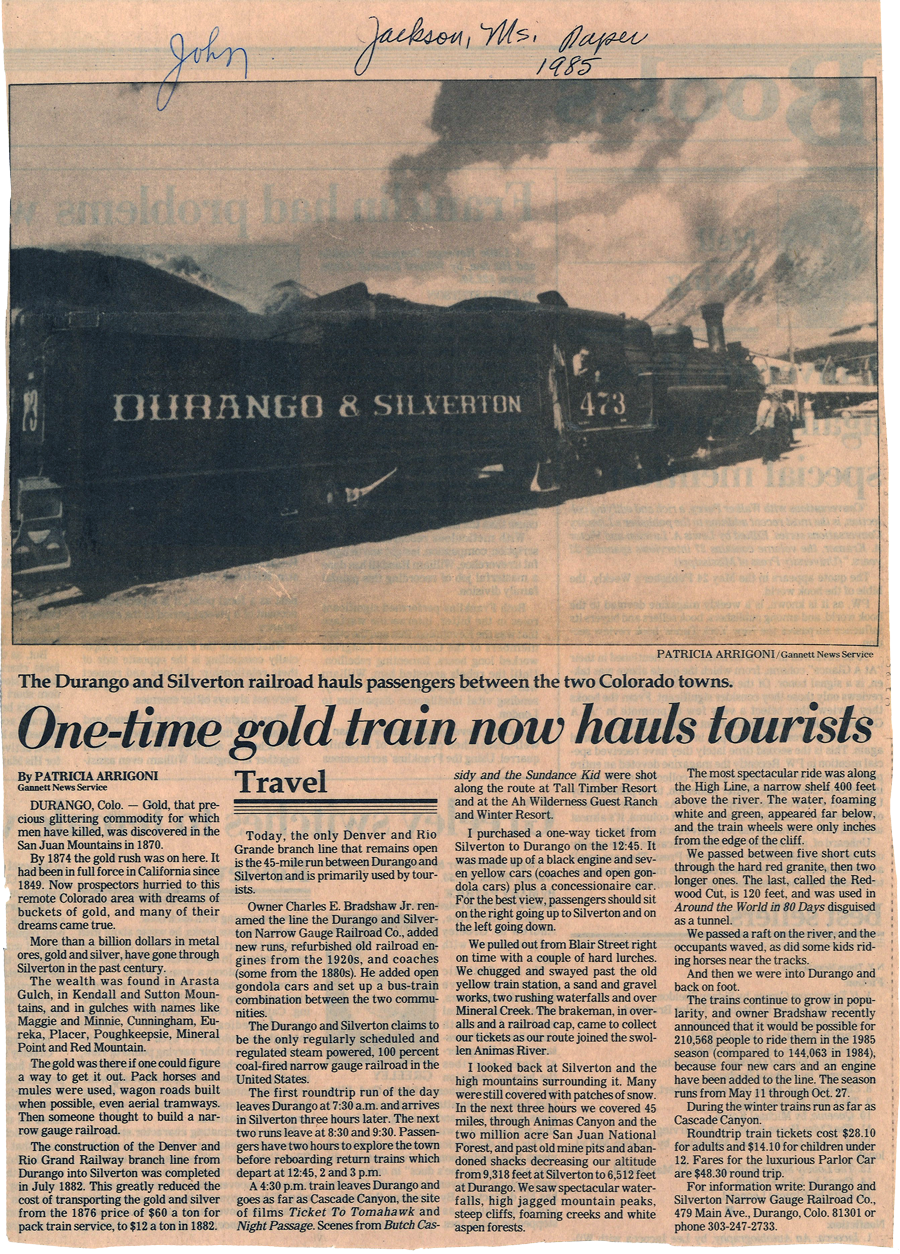
from Jackson, Mississippi Clarion-Ledger newspaper - 1985 / collection
 Snapshots
Snapshots

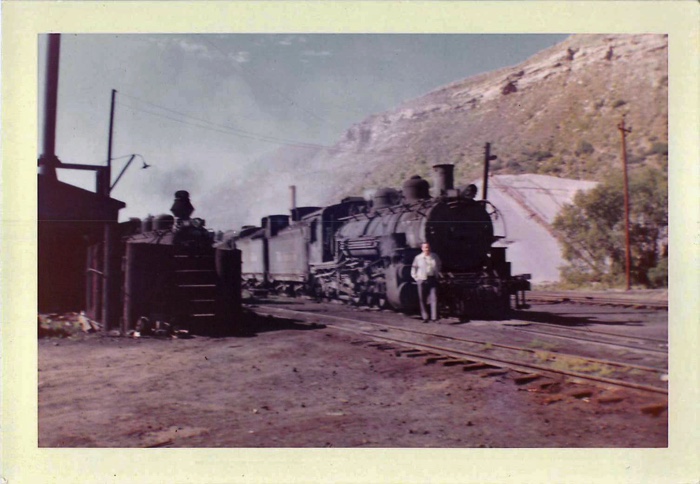 I was so pleased to find this snapshot at the bottom of shoebox full of photo odds and ends taken on my father's various twin-reflex cameras from the late 1950s and throughout the 1960s. He and my mother made a trek to Colorado in 1959, touring various railroad sites in my dad's 1955 Chevrolet Bel Air and taking a ride on the Durango & Silverton route (before it even bore that tourist name, still owned by the Rio Grande). Certainly my mother must have taken this particular image. Although the photo lacks some sharpness, the color tones seem just right for a 1959 photo. I'm guessing that white shirt was not so clean by the end of their ride along the famous river line. Down below, other snapshots from their 1959 adventures in the Centennial State are shown as well.
I was so pleased to find this snapshot at the bottom of shoebox full of photo odds and ends taken on my father's various twin-reflex cameras from the late 1950s and throughout the 1960s. He and my mother made a trek to Colorado in 1959, touring various railroad sites in my dad's 1955 Chevrolet Bel Air and taking a ride on the Durango & Silverton route (before it even bore that tourist name, still owned by the Rio Grande). Certainly my mother must have taken this particular image. Although the photo lacks some sharpness, the color tones seem just right for a 1959 photo. I'm guessing that white shirt was not so clean by the end of their ride along the famous river line. Down below, other snapshots from their 1959 adventures in the Centennial State are shown as well.
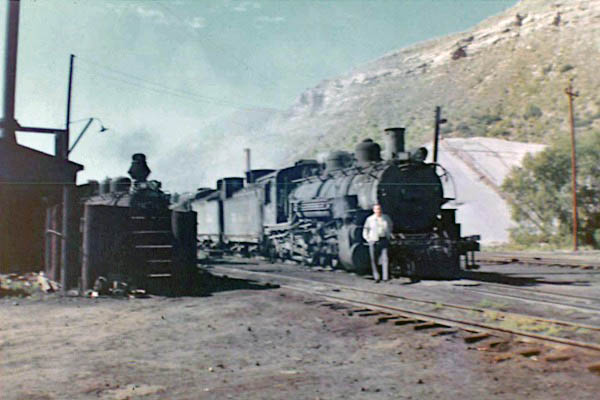
Durango, Co / Jun 1959 / Lucile Hawkins
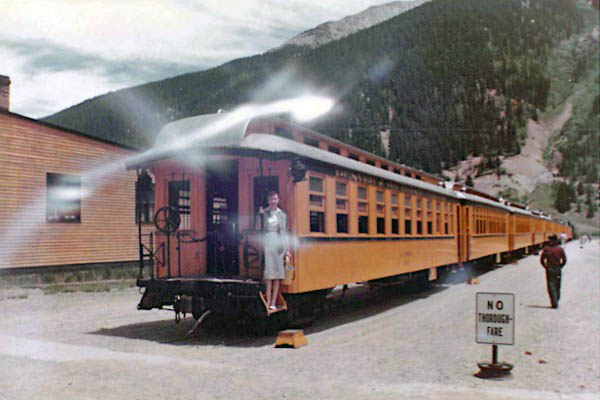
Silverton, Co / Jun 1959 / JCH
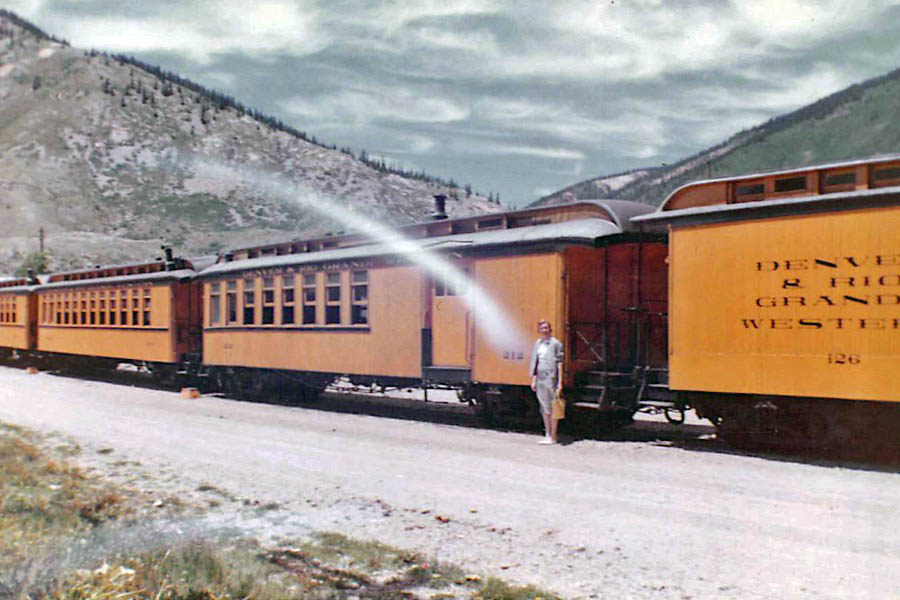
Silverton, Co / Jun 1959 / JCH
 Colorado Vacation
Colorado Vacation
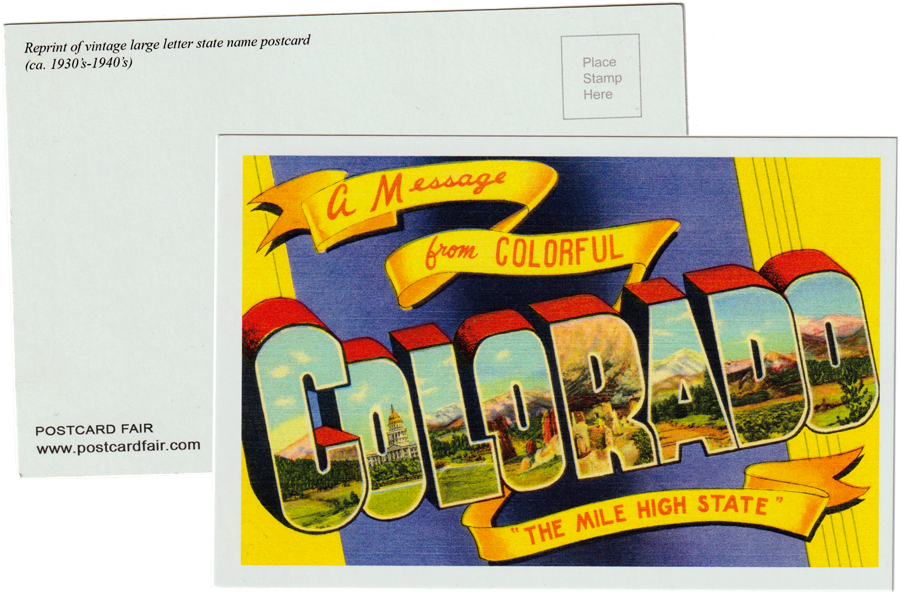
postcard / collection
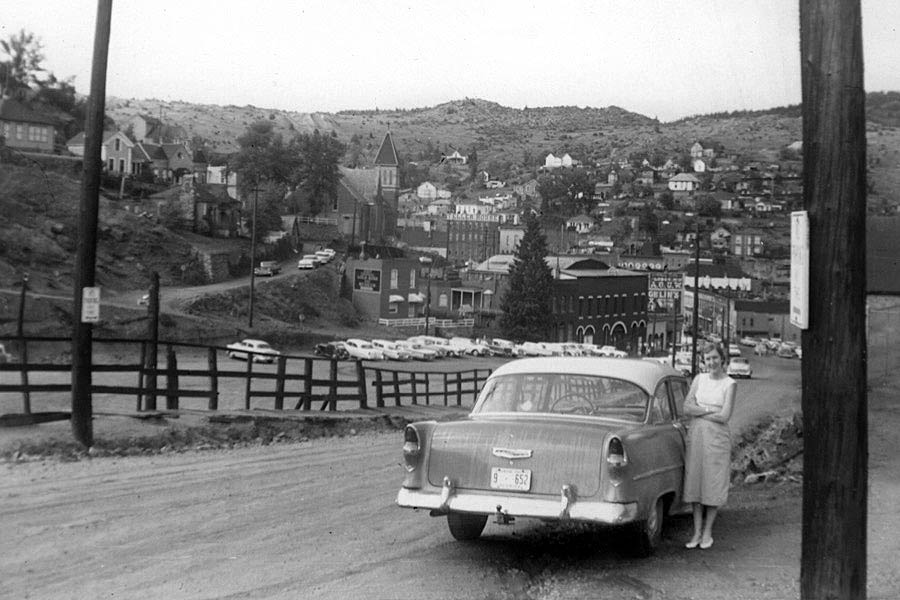
Jun 1959 / JCH
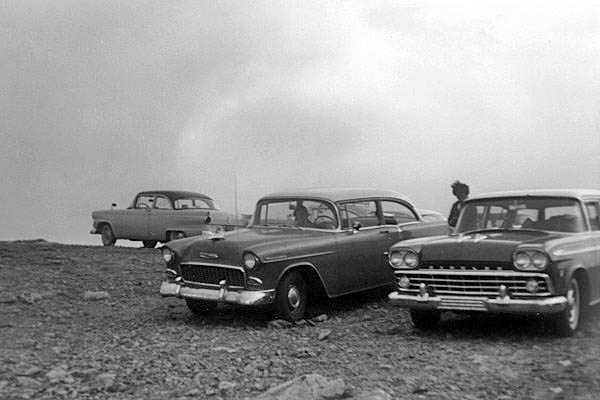
Pikes Peak, Co / Jun 1959 / JCH
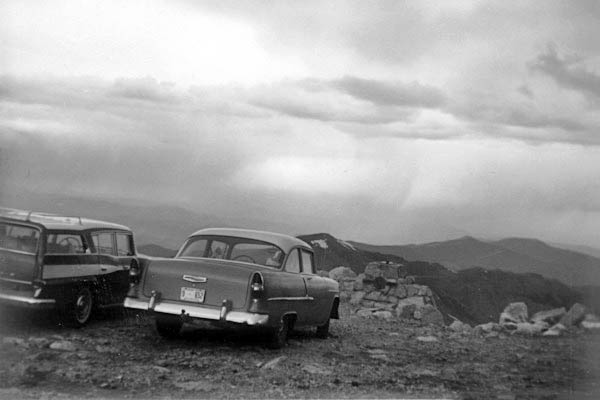
Pikes Peak, Co / Jun 1959 / JCH
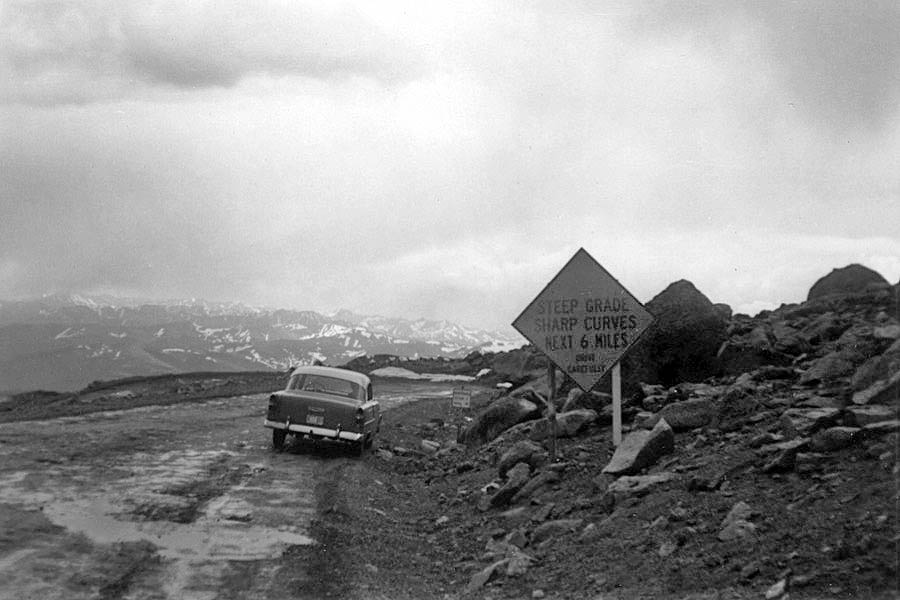
Pikes Peak, Co / Jun 1959 / JCH
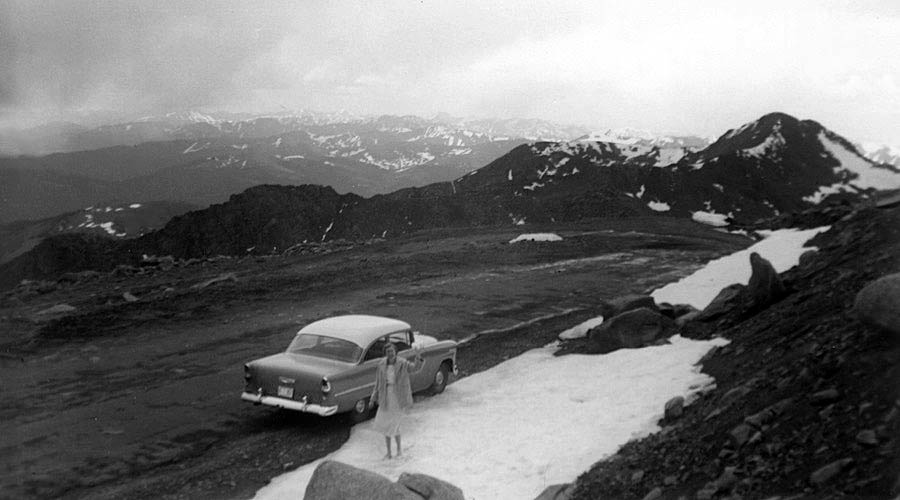
Pikes Peak, Co / Jun 1959 / JCH

See also our complete Pikes Peaks Cog Railway scrapbook in Preservation
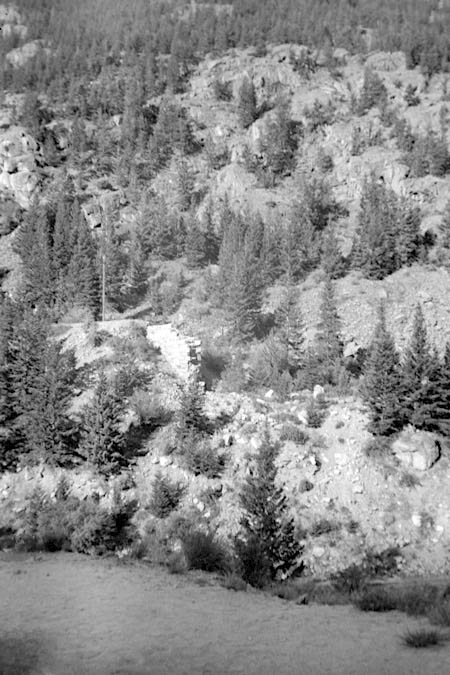
Central City, Co / Jun 1959 / JCH
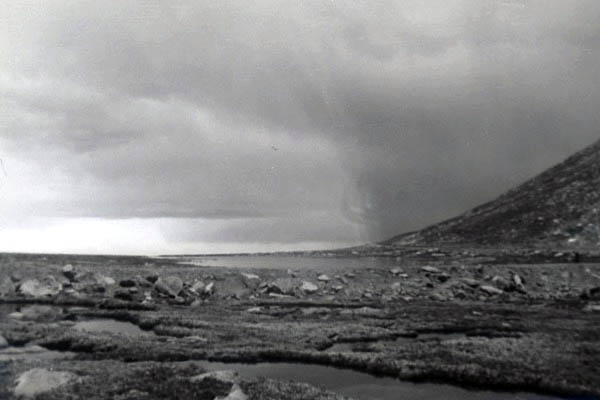
Jun 1959 / JCH
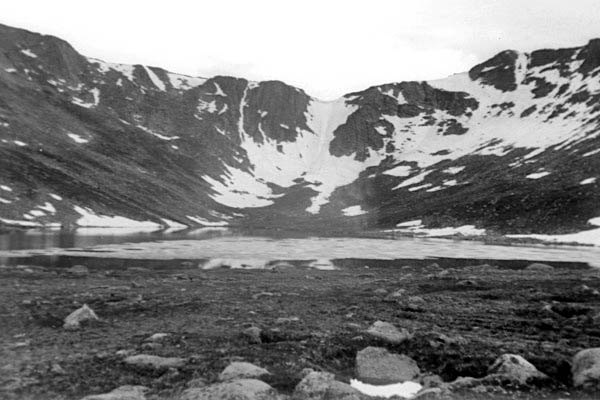
Jun 1959 / JCH
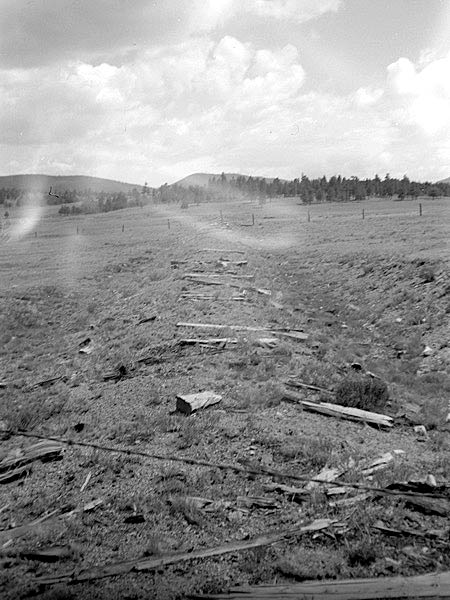
Jun 1959 / JCH
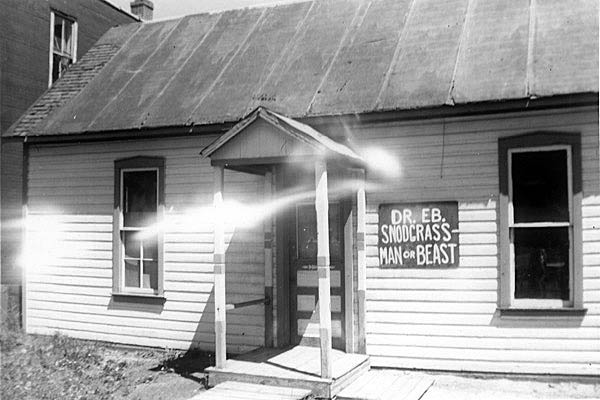
Jun 1959 / JCH
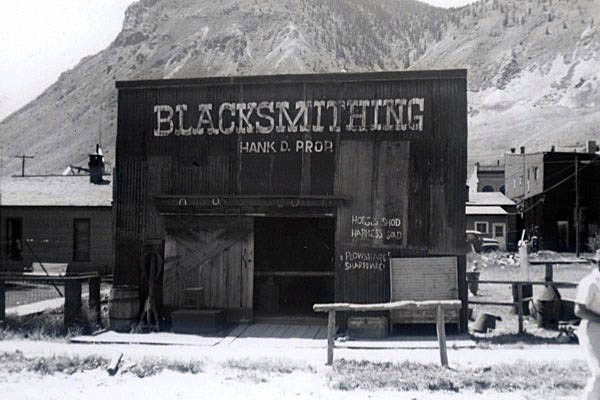
Jun 1959 / JCH
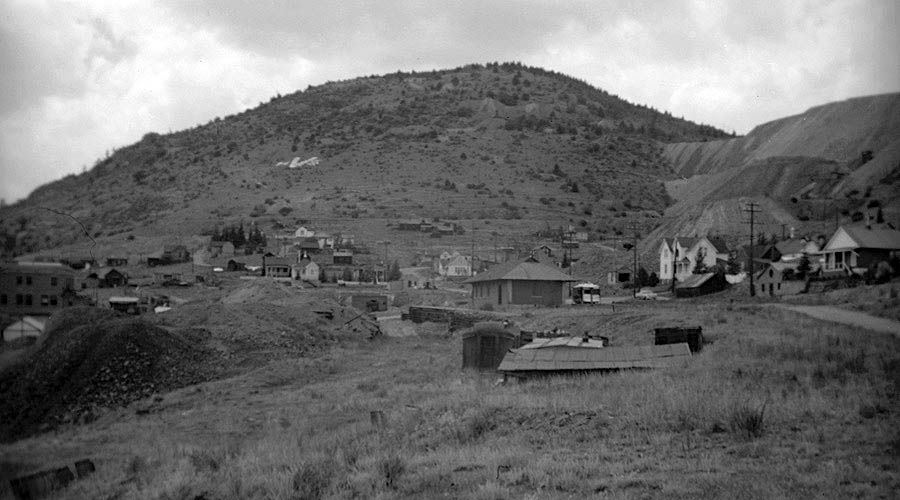
Victor, Co / Jun 1959 / JCH
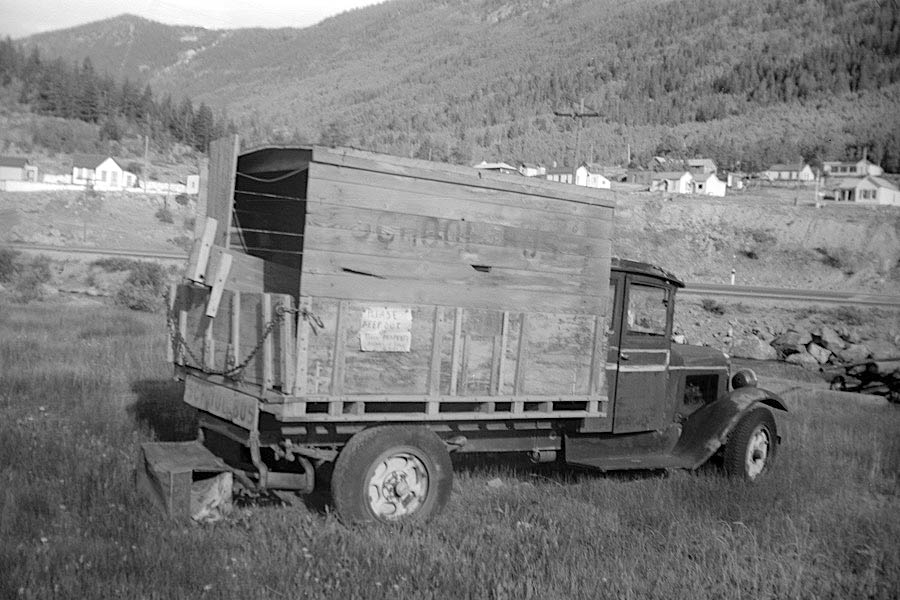
Jun 1959 / JCH
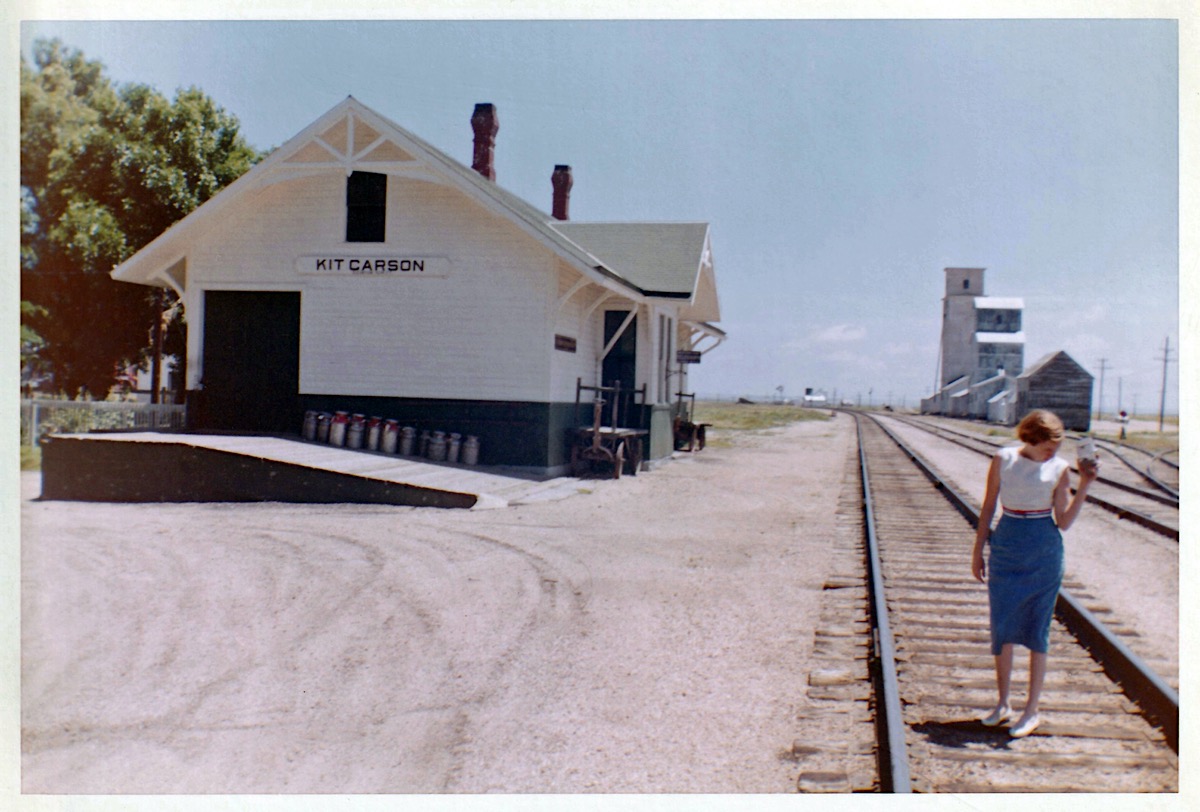
Kit Carson, Co / Jun 1959 / JCH
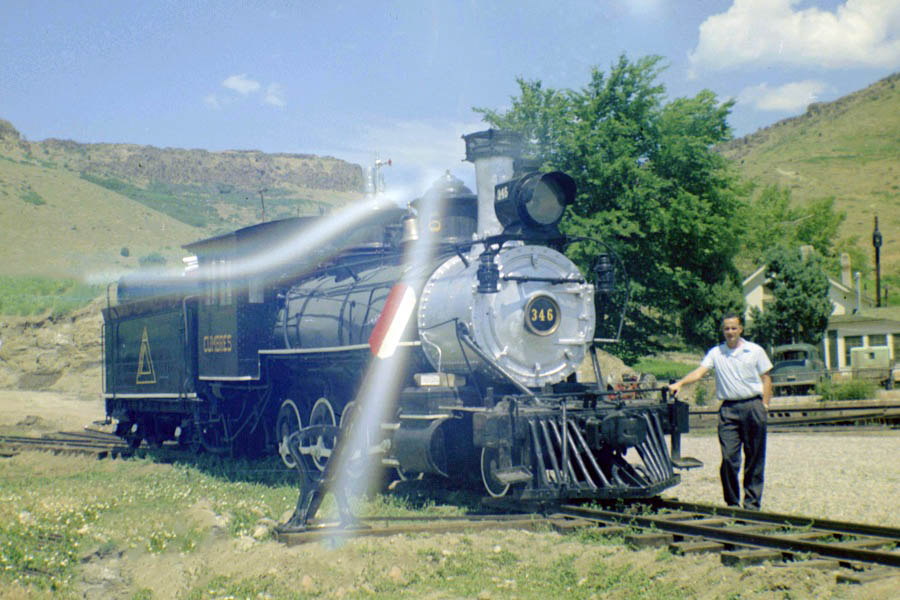
Golden, Co / Jun 1959 / Lucile Hawkins
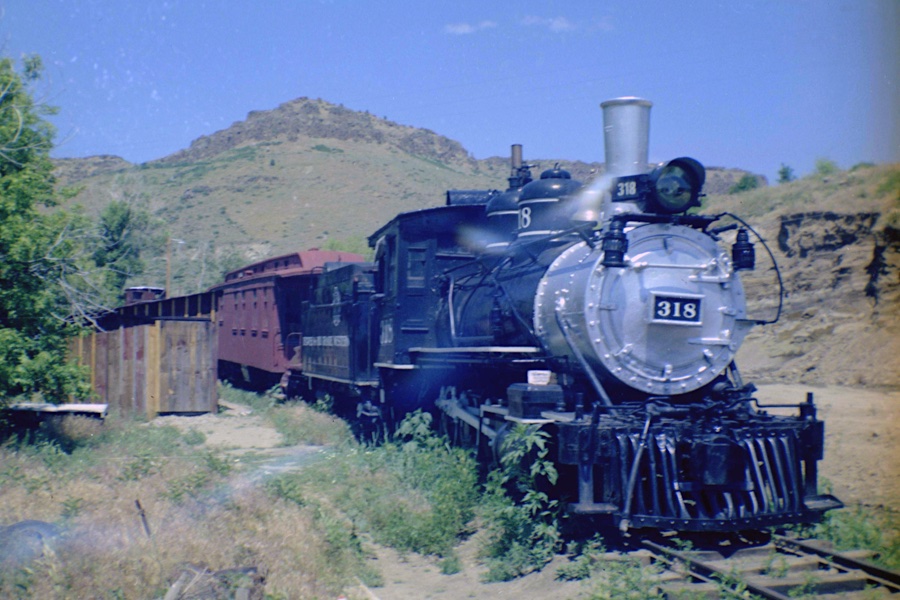
Golden, Co / Jun 1959 / JCH
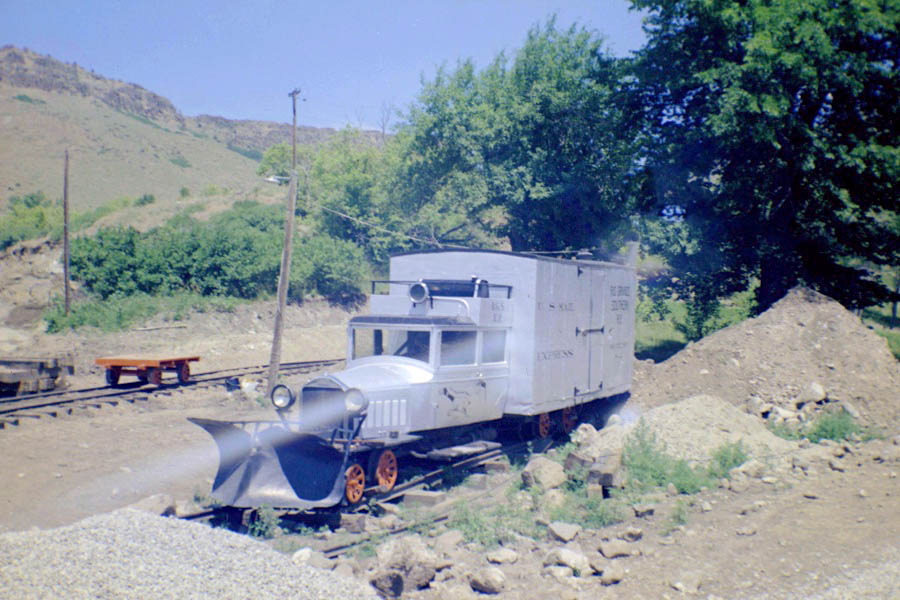
Golden, Co / Jun 1959 / JCH

See also our complete Colorado Railroad Museum featured scrapbook in Preservation
Links / Sources
- Colorado Encyclopedia page for Durango & Silverton Narrow Gauge Railroad
- Western Mining History pages for Durango and Silverton
- Wikipedia article for Durango and Silverton Narrow Gauge Railroad
- John B. Hungerford, Narrow Gauge to Silverton — Fourth Edition (Hungerford Press, 1958)
- Lucius Beebe & Charles Clegg, Narrow Gauge in the Rockies (Howell-North, 1958) 12-93
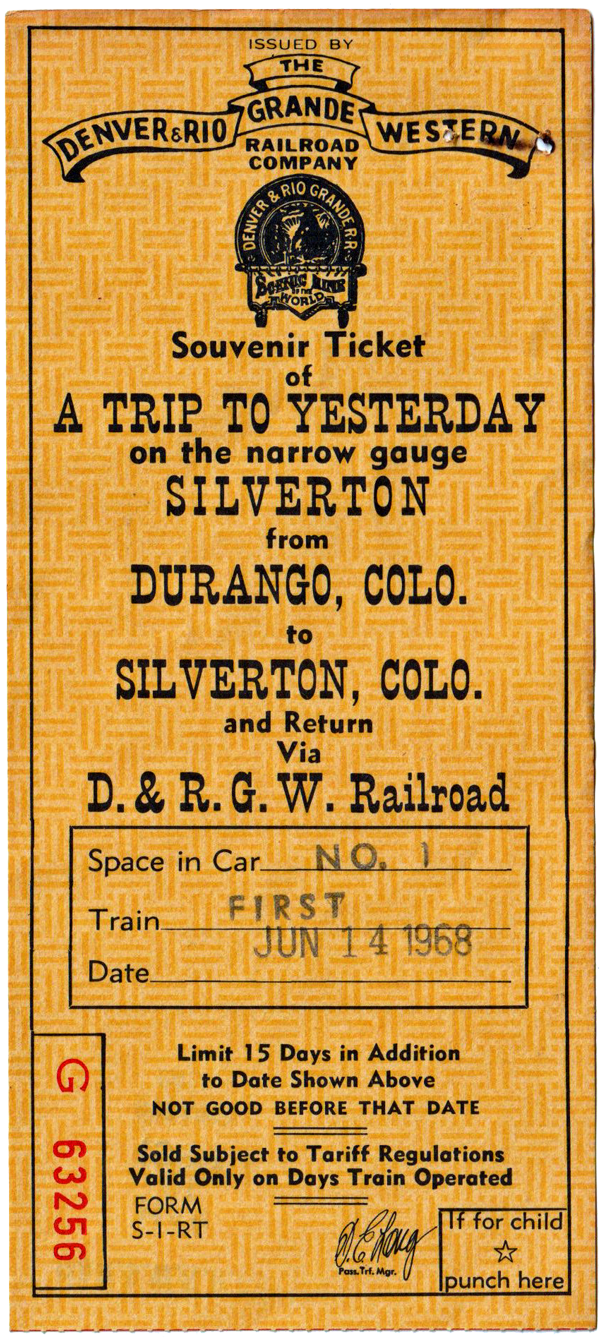
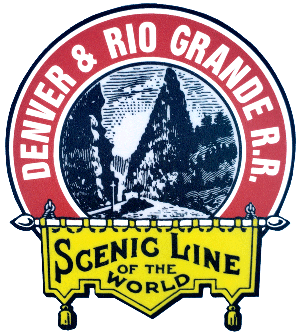
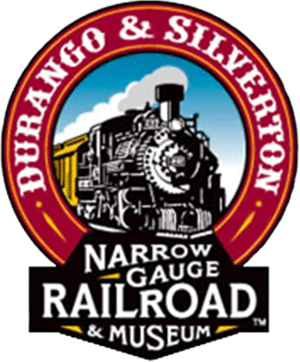 By the 1960s, the modern Denver & Rio Grande Western no longer wanted to operate the remote Silverton line or its slim gauge tourist trains, and thus petitioned the Interstate Commerce Commission for abandonment. The petition was denied, because the route was determined to be so important for regional tourist patronage. As a result of the ruling, the mainline railroad reluctantly made investments in the branchline, its locomotives and rolling stock, and the Durango depot. D&RGW operated the Silverton as a dedicated steam-powered narrow gauge tourist-hauler throughout the 1970s. However, the line was sold in 1979 to Charles Bradshaw, a monied Florida citrus grower, thus ending the Denver-based railroad's century-long 36-inch presence in the San Juan mountains. Bradshaw kept the line active as a popular tourist hauler, and today the Silverton branchline is owned by American Heritage Railways and operated as the
By the 1960s, the modern Denver & Rio Grande Western no longer wanted to operate the remote Silverton line or its slim gauge tourist trains, and thus petitioned the Interstate Commerce Commission for abandonment. The petition was denied, because the route was determined to be so important for regional tourist patronage. As a result of the ruling, the mainline railroad reluctantly made investments in the branchline, its locomotives and rolling stock, and the Durango depot. D&RGW operated the Silverton as a dedicated steam-powered narrow gauge tourist-hauler throughout the 1970s. However, the line was sold in 1979 to Charles Bradshaw, a monied Florida citrus grower, thus ending the Denver-based railroad's century-long 36-inch presence in the San Juan mountains. Bradshaw kept the line active as a popular tourist hauler, and today the Silverton branchline is owned by American Heritage Railways and operated as the 